For someone growing plants in meadows and naturalistic planting beds at ground level at our cottage on Lake Muskoka north of Toronto, I spend an inordinate length of time each summer watching a few mismatched pots on the upper deck right outside my cottage living room window.
At first it was just a pair of oversized resin pots planted with conventional annuals. In 2007, that meant ‘Profusion Orange’ zinnias, nasturtiums, ivy geraniums and peach and yellow African daisies (Osteospermum ‘Symphony Series’).
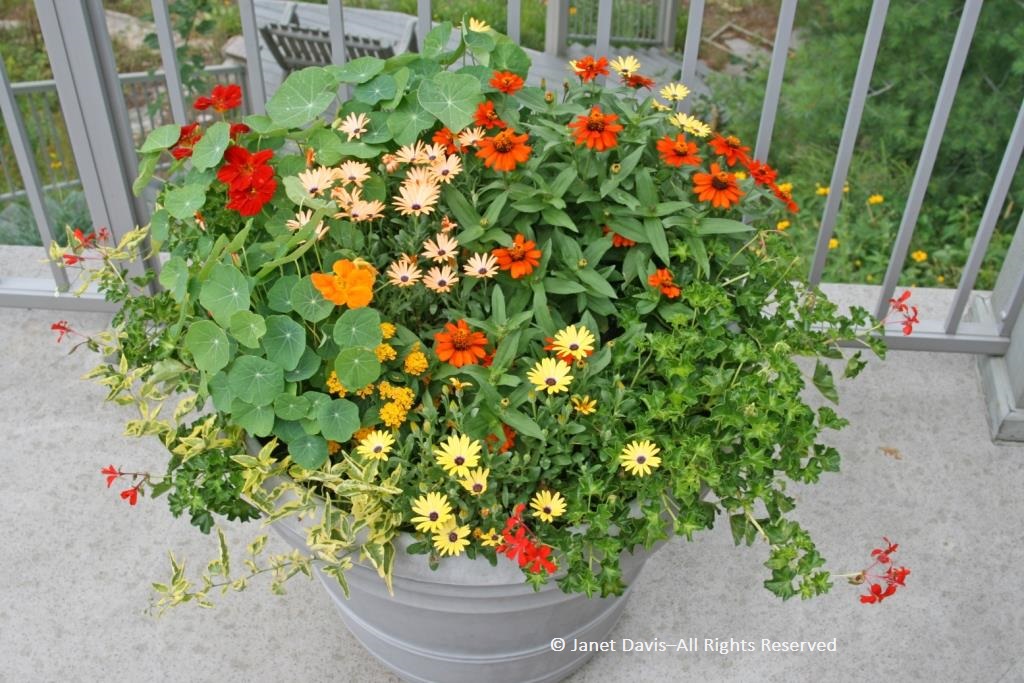
In 2011, I planted both pots with an eclectic mix of succulents, agastache and spiny porcupine tomato (Solanum pyracanthos) that I bought at the Toronto Botanical Garden’s spring plant sale.
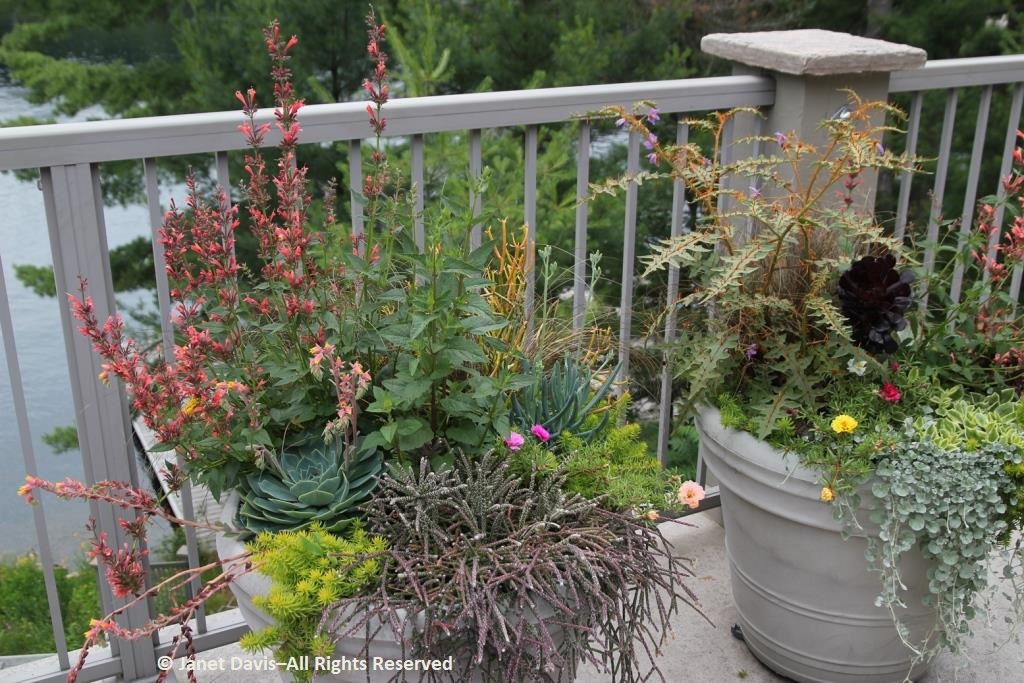
That was the first year I noticed that the ruby-thoated hummingbird seemed to be enjoying nectaring in the agastache flowers.
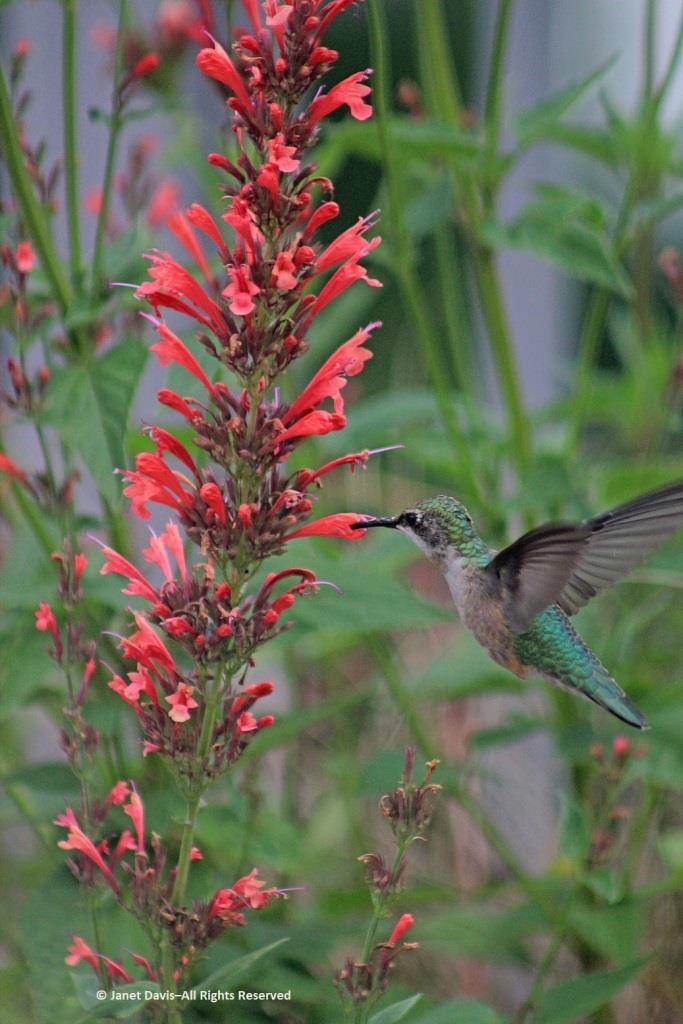
In 2012, my pots featured the few succulents I was able to winter over in a sunny ground floor window as well as a swath of colourful portulaca.
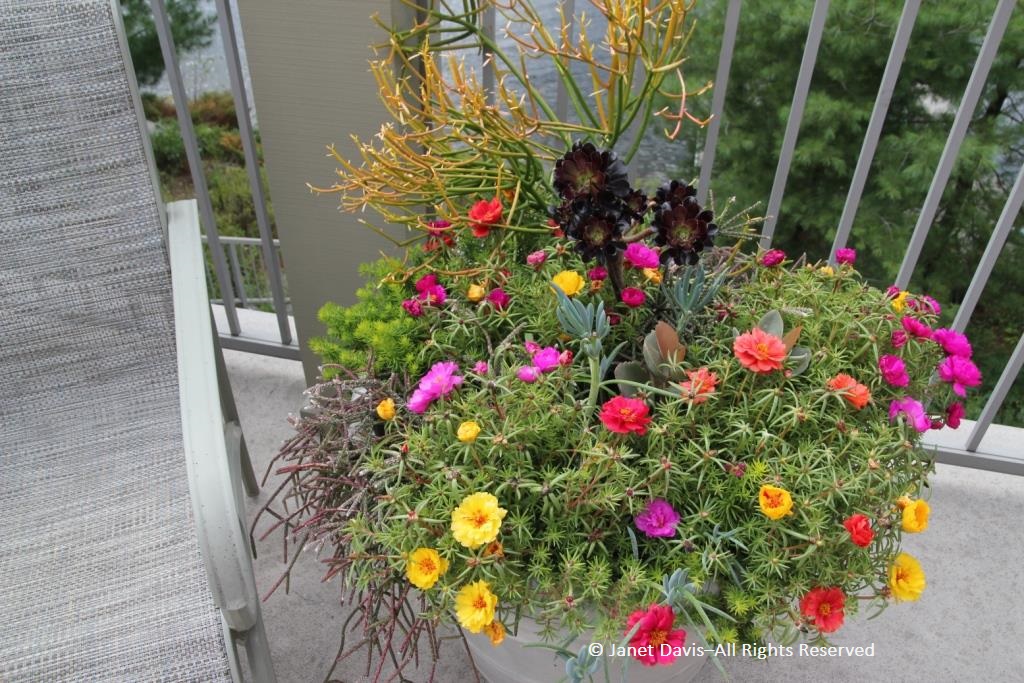
In 2015, with photography on my mind, I paid more attention to hummingbird favourites, shopping at a favourite nursery (Toronto’s Plant World, sadly now closed) to buy a selection of salvias and agastaches (aka hummingbird mints) I called my “hummingbird groceries”.
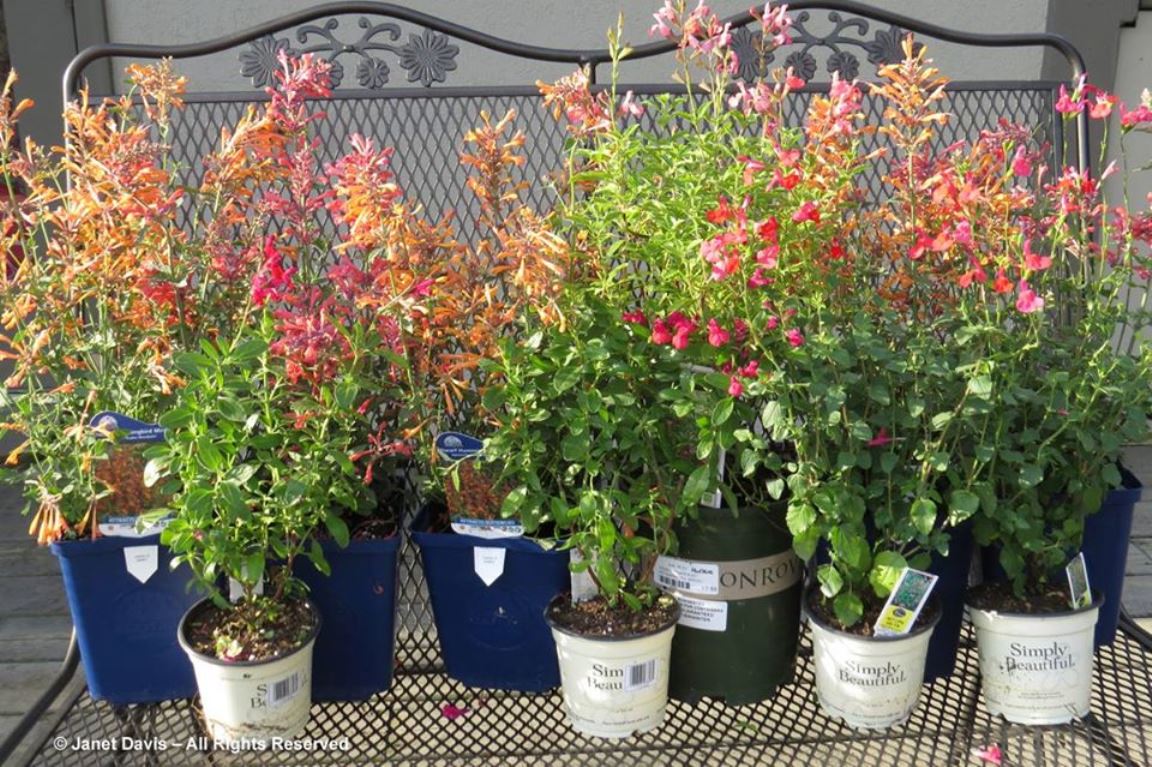
One pot featured deep-pink calibrachoa, orange portulaca and ‘Zahara Double Orange’ zinnias with Agastache ‘Kudos Series’.
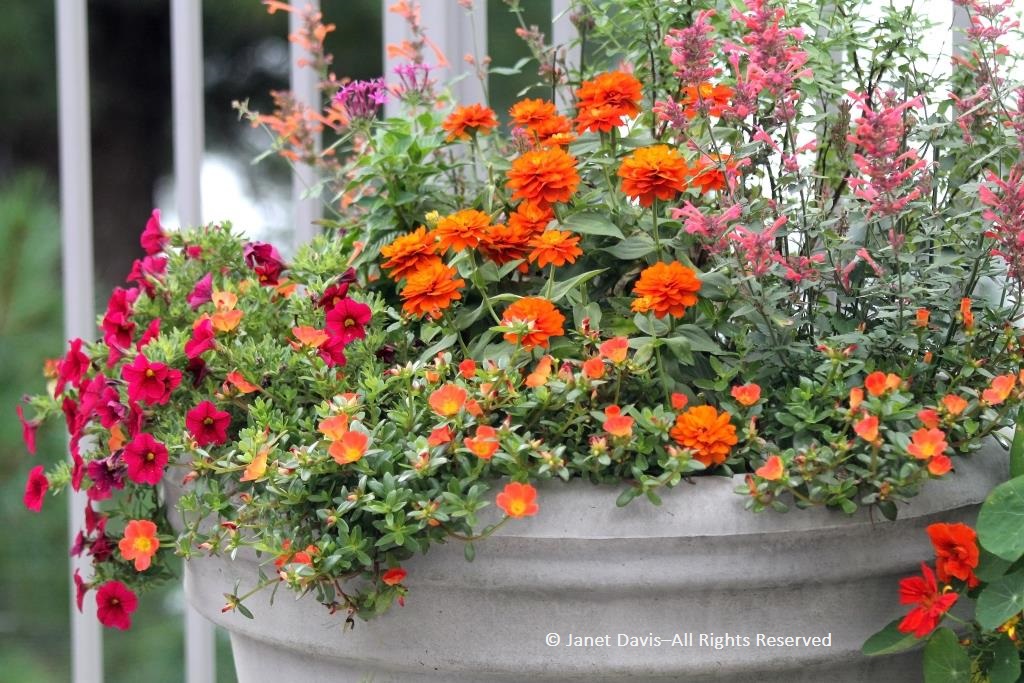
The hummingbirds loved Agastache ‘Kudos Coral’.
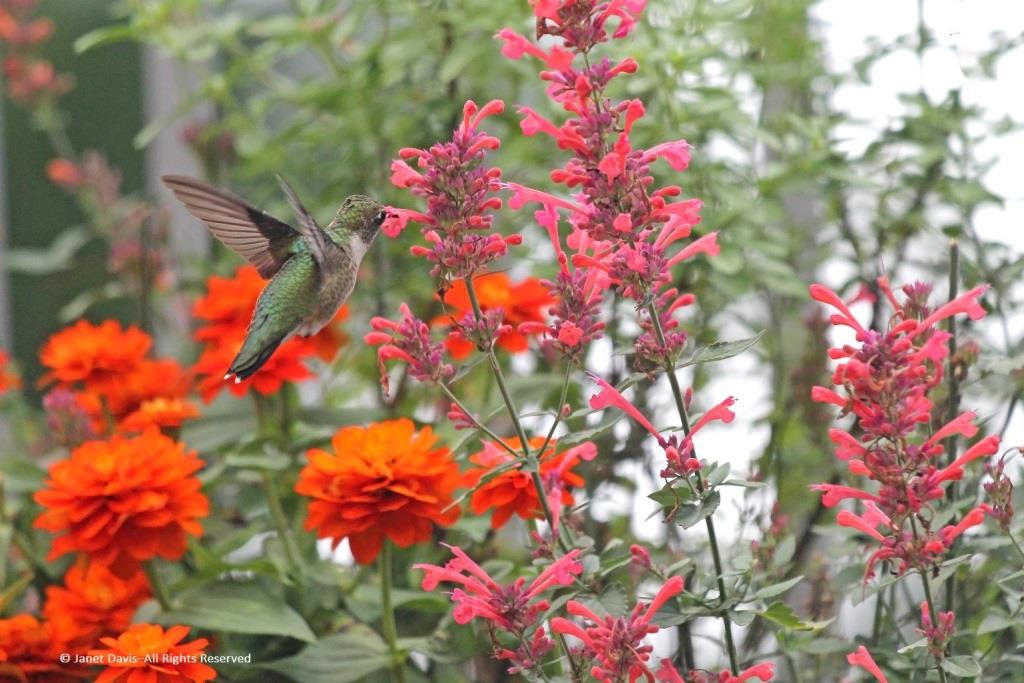
I added a third pot that summer, planting it with Bidens ferulifolia ‘Campfire Fireburst’ (an over-rated plant)….
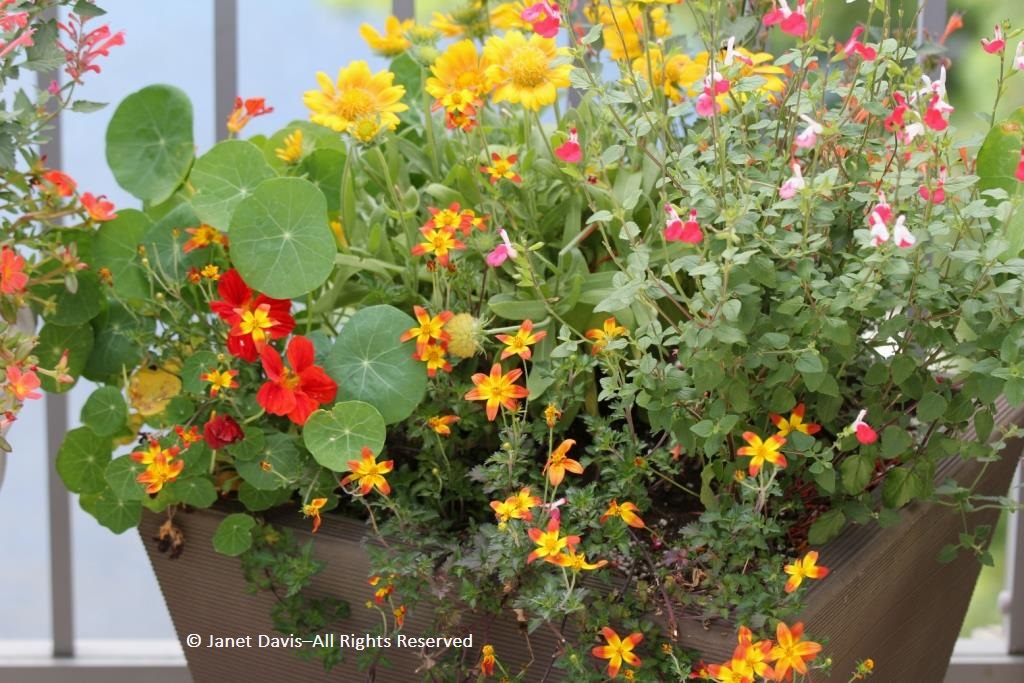
….. and some special salvias or sages, including Salvia microphylla ‘Hot Lips’.
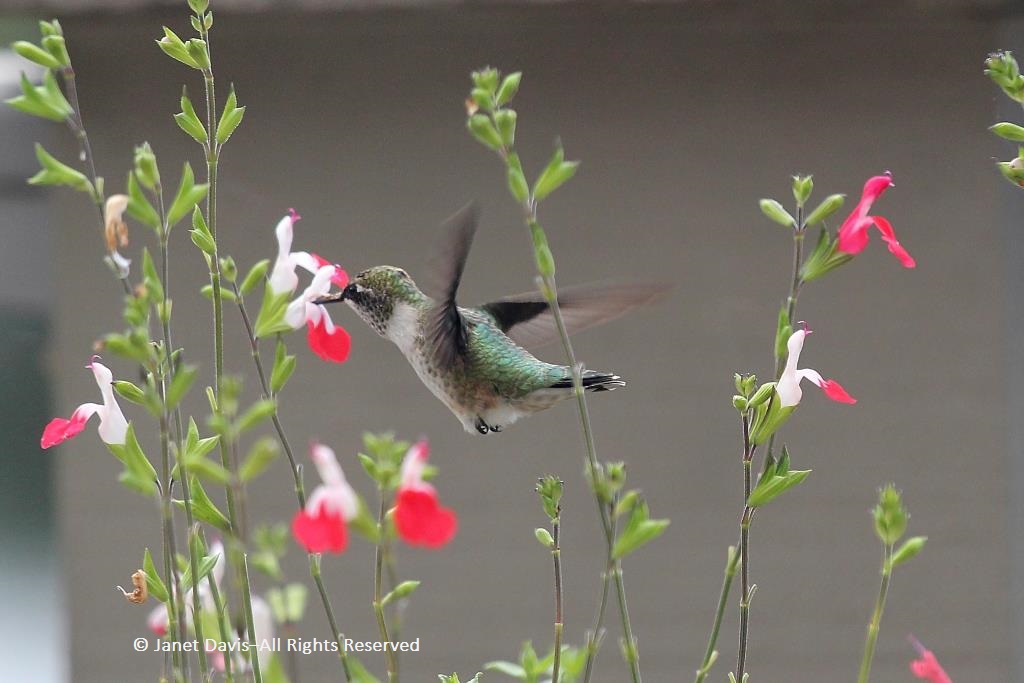
The hummingbird supped a little in an ordinary nasturtium too.
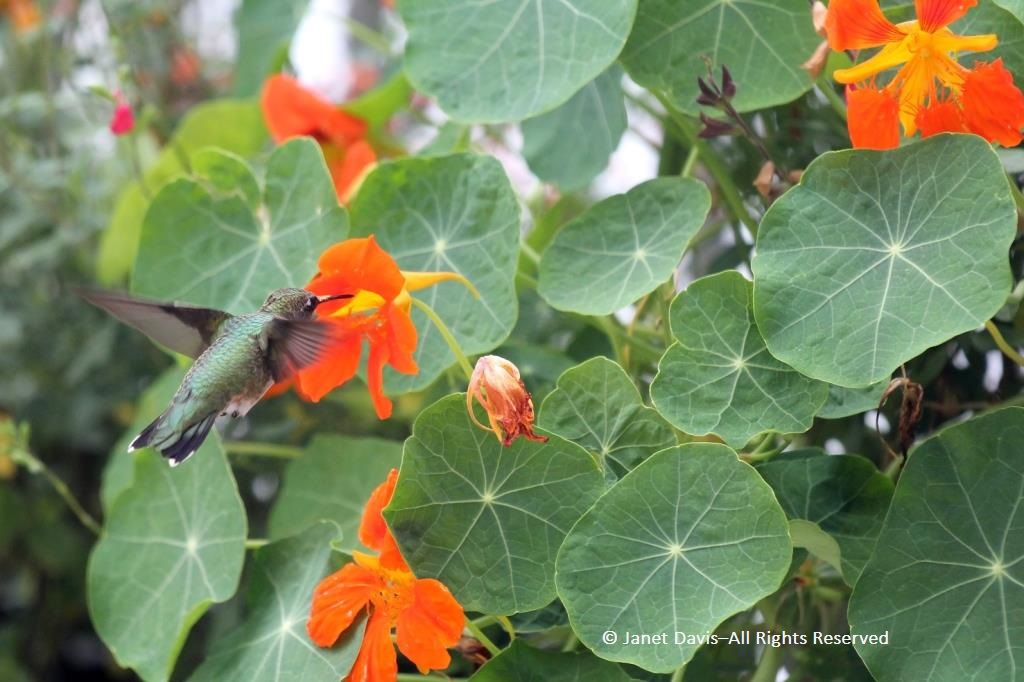
In 2016, I couldn’t find all the plants I wanted so I filled in with assorted fancy petunias. I also found holy basil or tulsi (Ocimum tenuiflorum) which is one of the most amazing bee plants. Since I do a lot of native bee photography, I never had to go far to find a huge assortment of bees to photograph…..
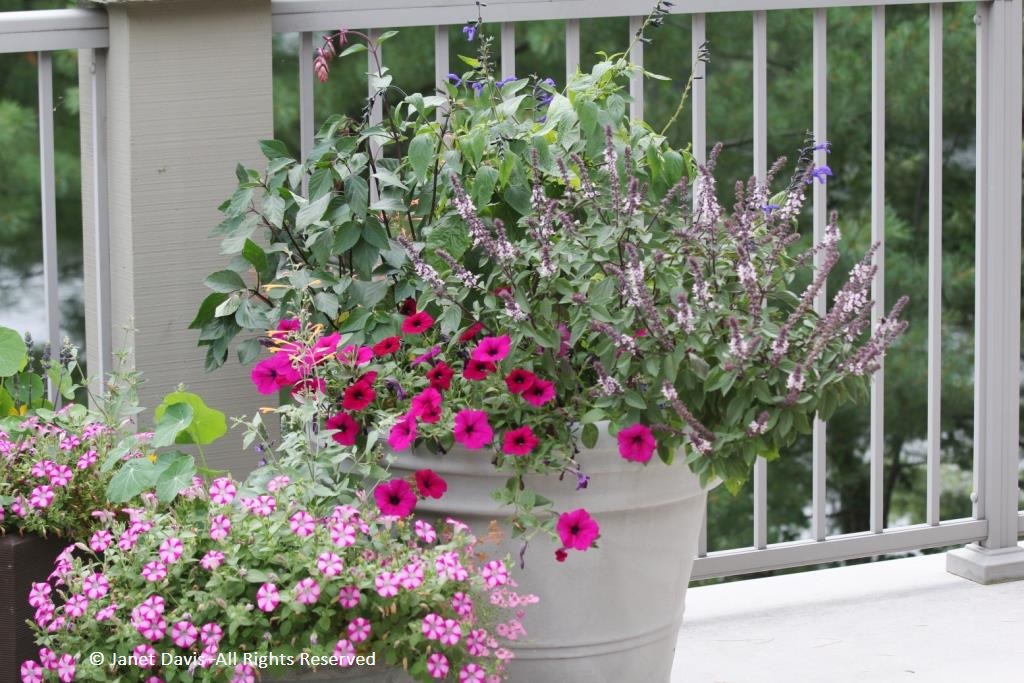
…… including the tiny green sweat bee (Augochlora pura).
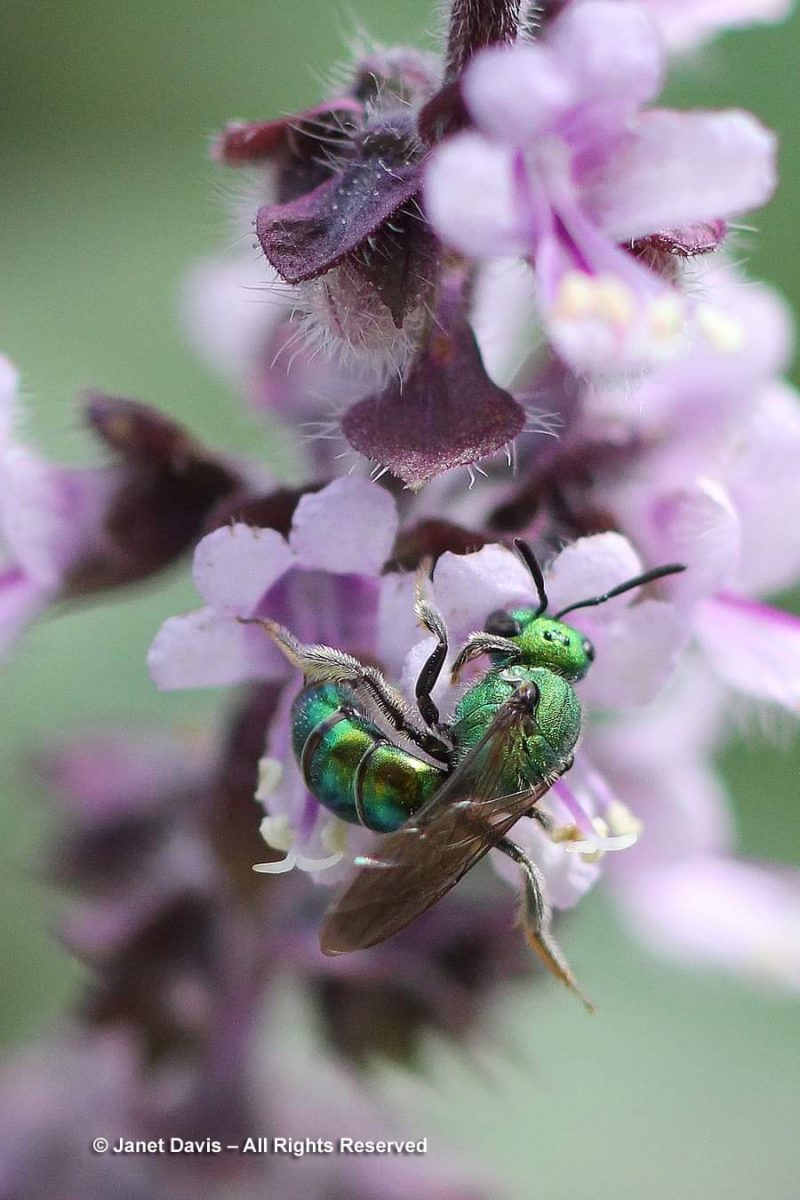
But that was the year I discovered that hummingbirds love the Wish series of salvias, including Salvia ‘Ember’s Wish’ below.
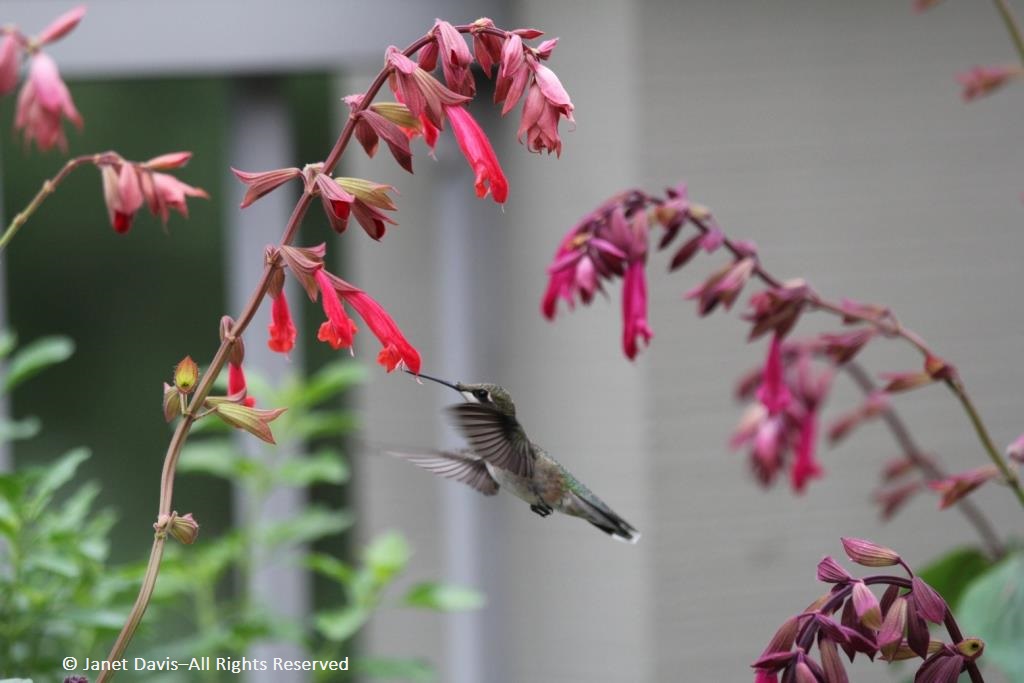
The next year, 2017 (notice I added two additional very motley pots from the back of the cottage), I had a pleasant surprise. The striped and ‘Wave’ series petunias I’d grown the previous year self-seeded in the soil over winter and…
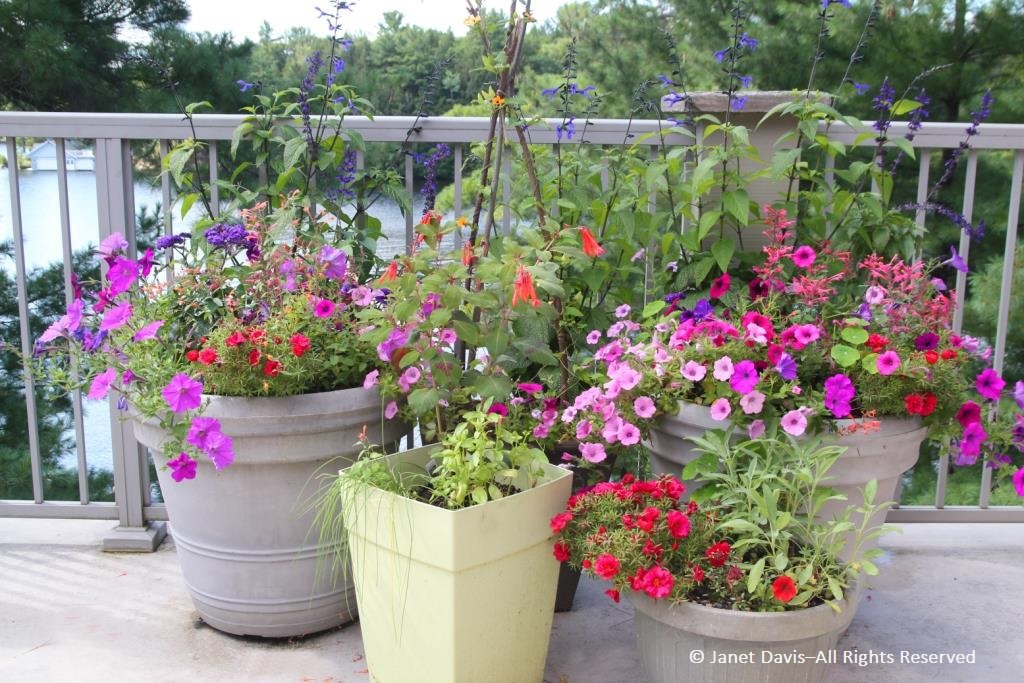
….. produced a beautiful mix of healthy hybrids in all kinds of jewel colours. I liked them much better than the originals, and some had that old-fashioned fragrance.
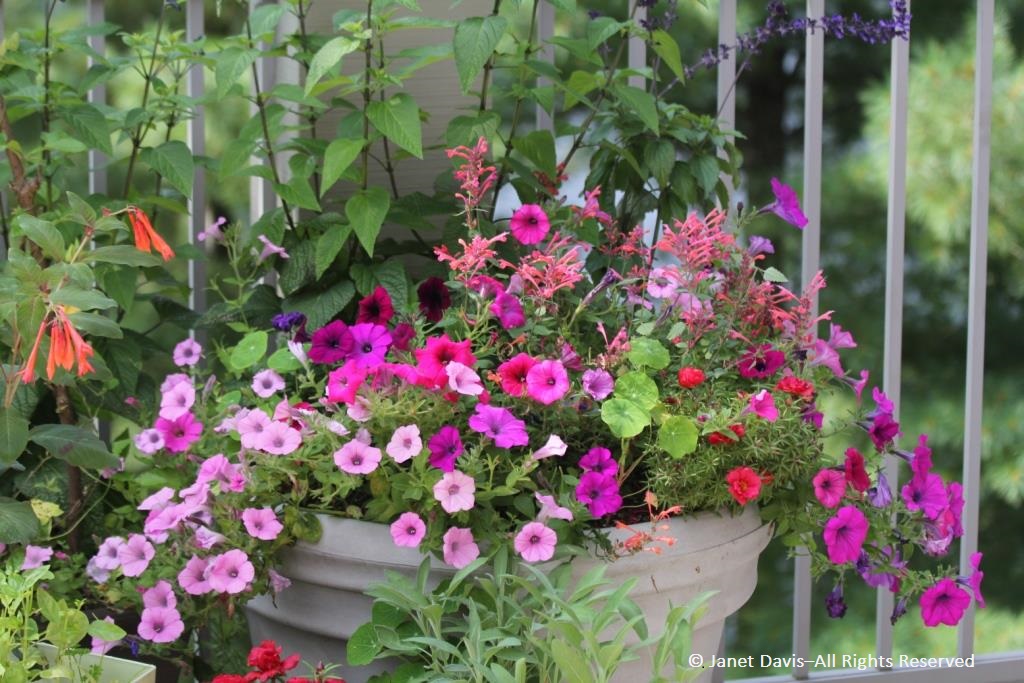
I also grew heliotrope (Heliotropium arborescens) for its sweet perfume and was pleased to welcome back self-seeded ‘Apricot Sprite’ agastache (A. aurantiacum)……
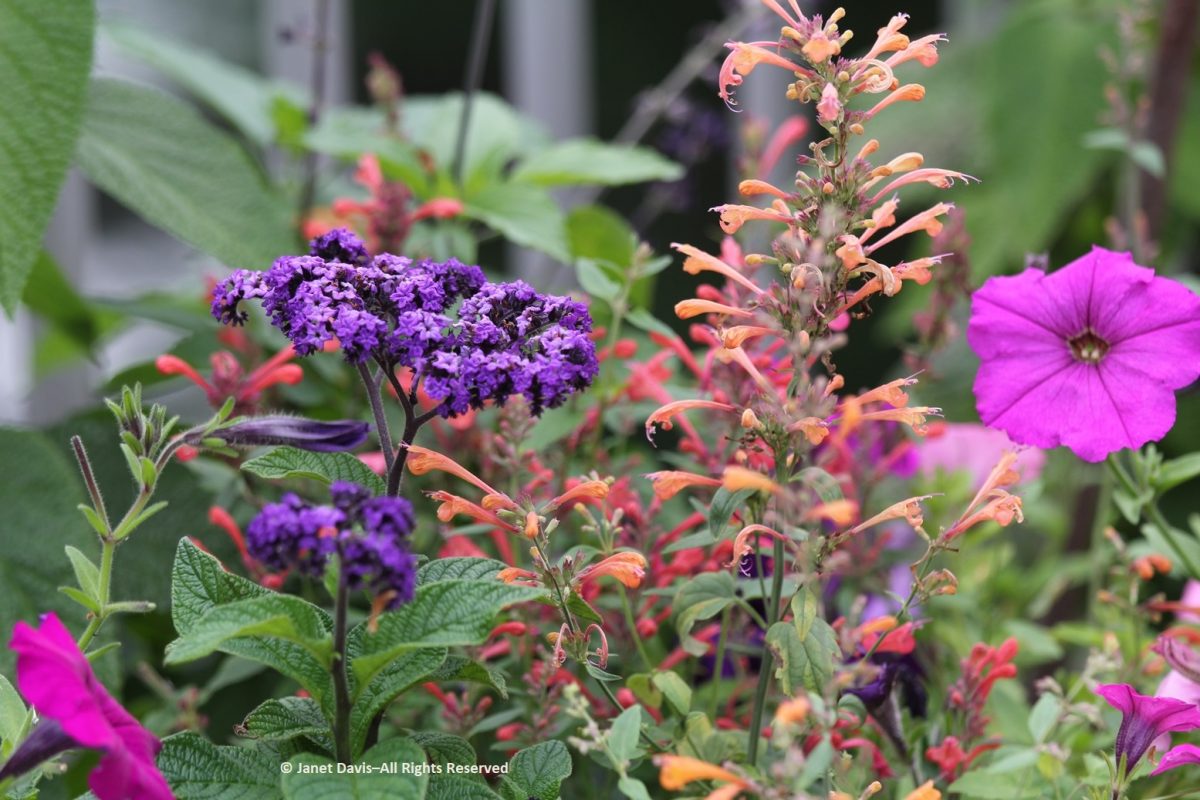
….. which is always a hummingbird menu choice.
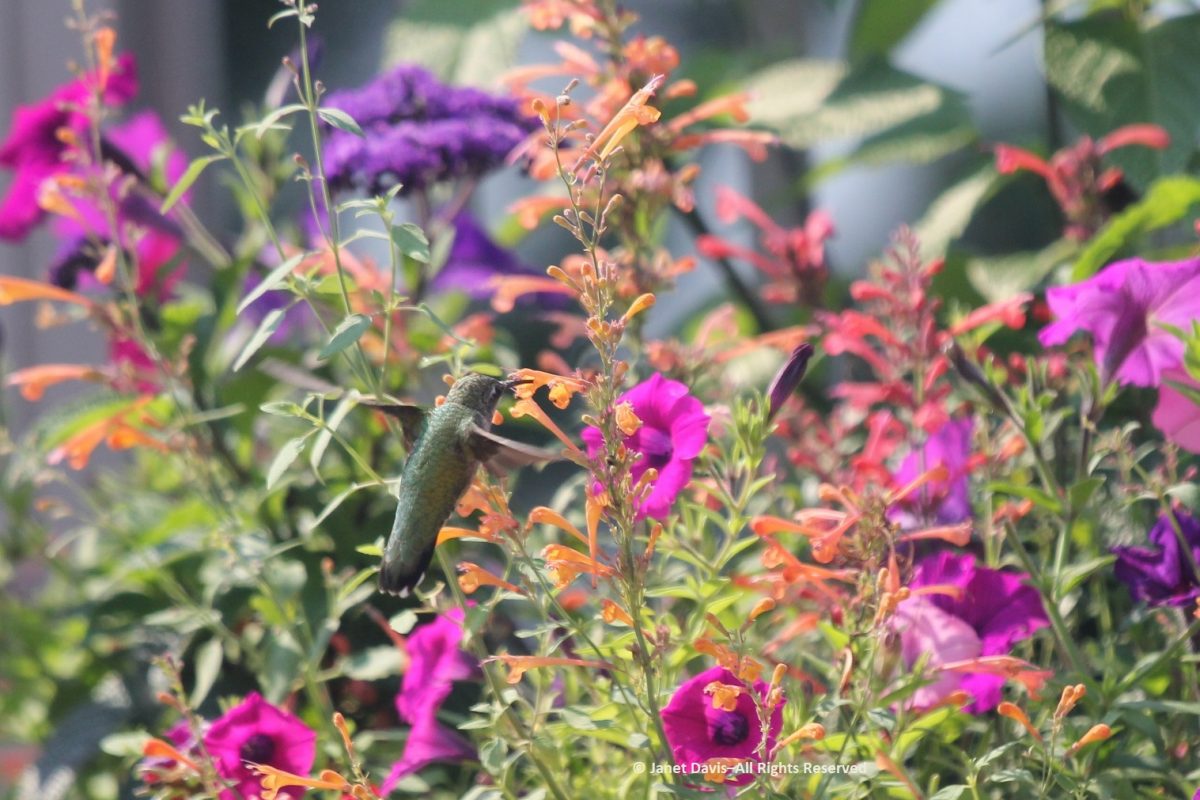
That year I also grew blackeyed susan vine (Thunbergia alata ‘Susie Yellow‘) on a tripod in one of the pots and caught the hummingbird checking it out on occasion.
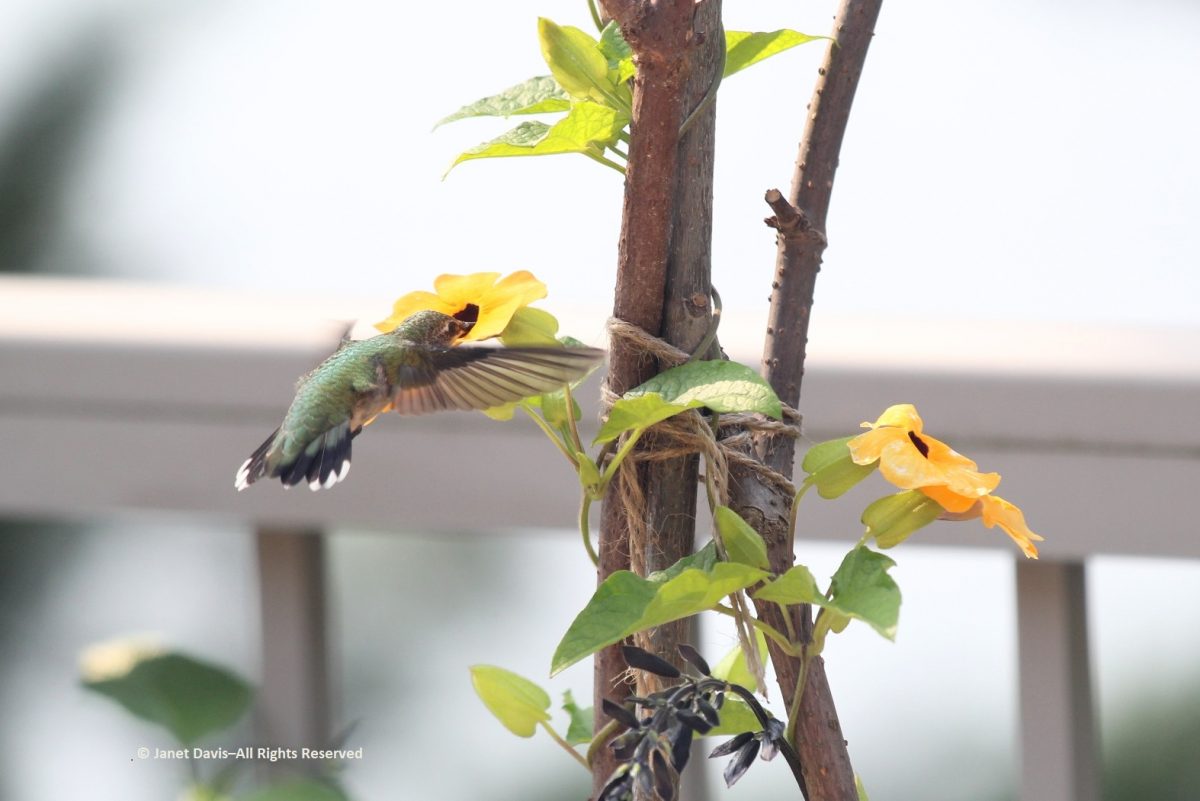
In 2018, I worked on my close-up photography. It’s not that easy to get photos of the male ruby-throated (it’s the male that sports the rosy neck feathers or gorget), since males migrate south much earlier than females, usually by the end of July. But here is monsieur on Salvia guaranitica ‘Black and Blooms’.
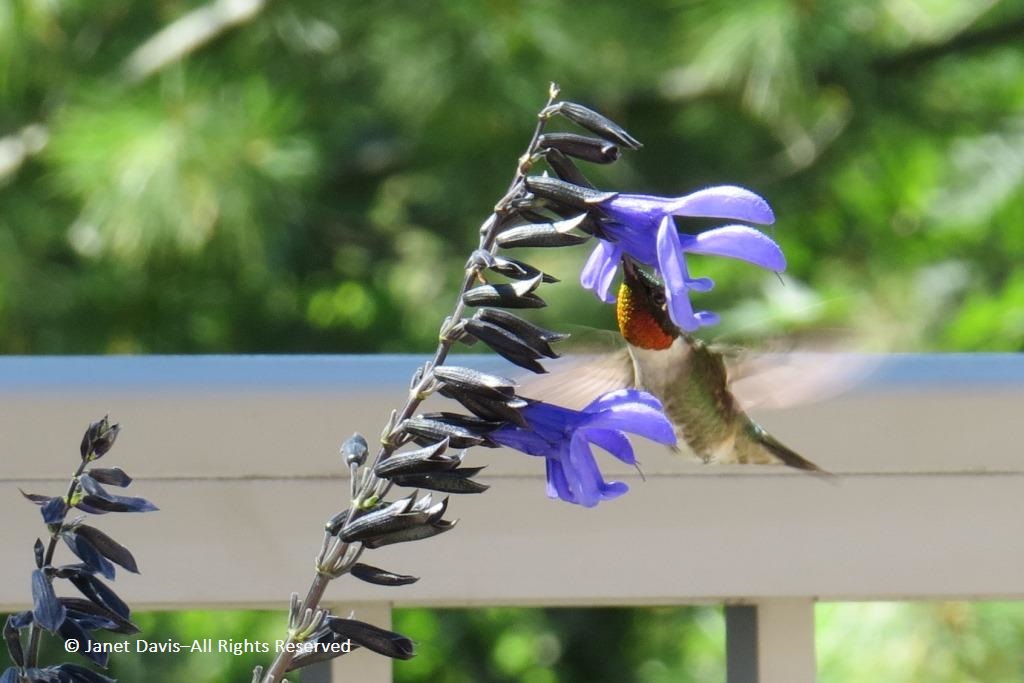
It was fun to try Lantana montevidensis that year, and someone approved!
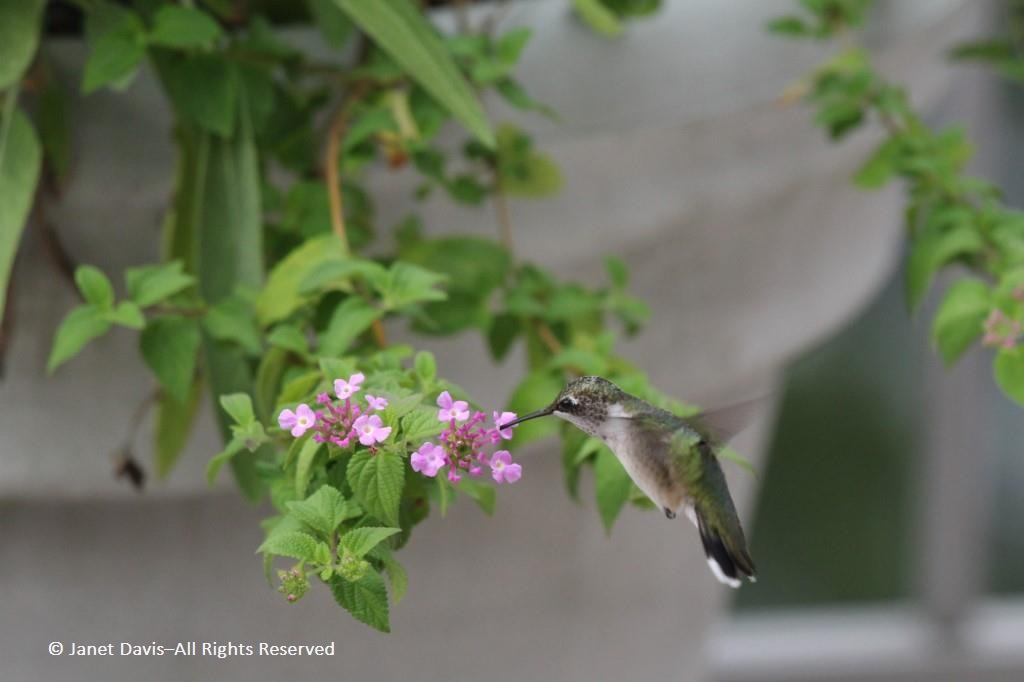
As always, the self-seeded ‘Apricot Sprite’ (Agastache aurantiacum) was popular not just with hummingbirds, but with the odd bumble bee too.
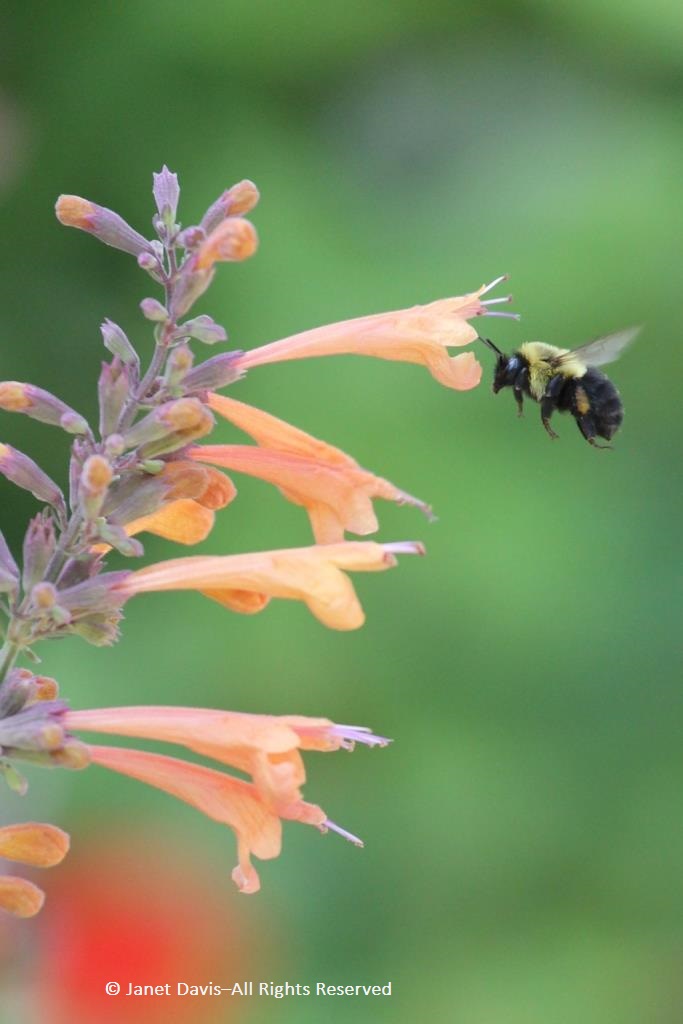
For 2019, my motley pots featured the usual suspects in the sage department, and I added a little birdbath which was never visited (though pretty)…..
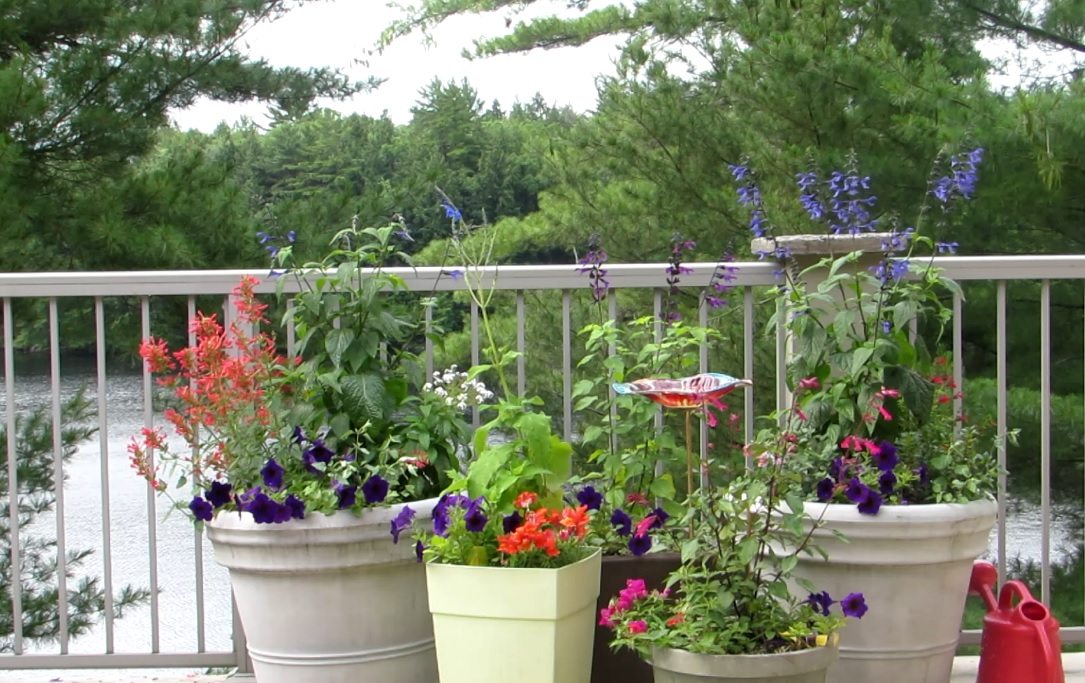
….. and one unusual Betsy Clebsch (California’s sage queen) hybrid called Salvia ‘Big Swing’. It was visited once in a while, but it wasn’t as popular as….
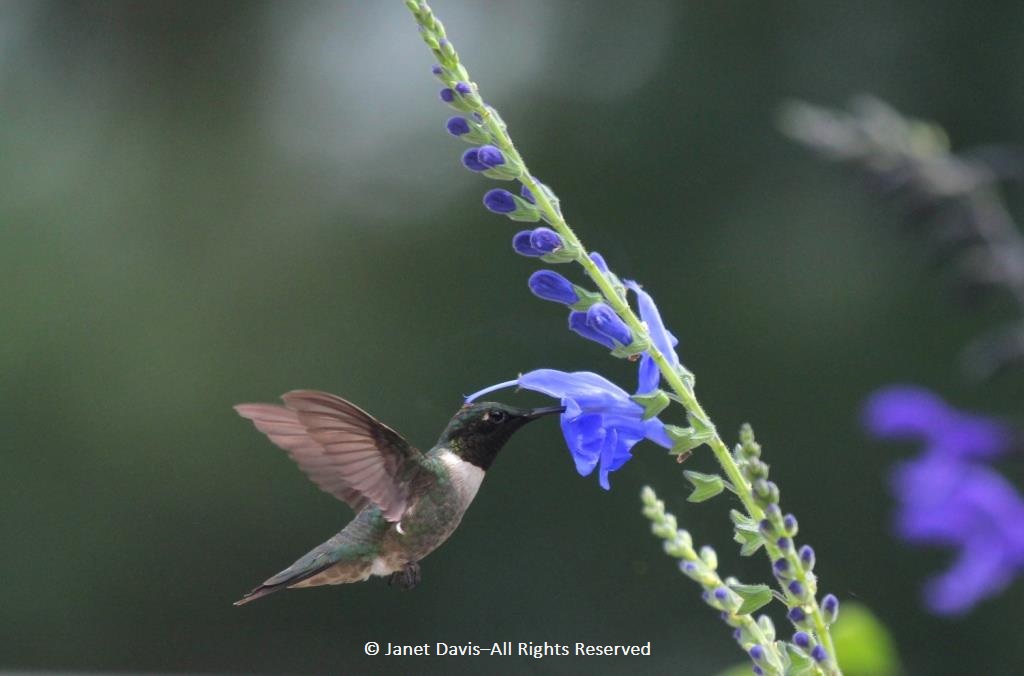
…..Salvia ‘Amistad’….
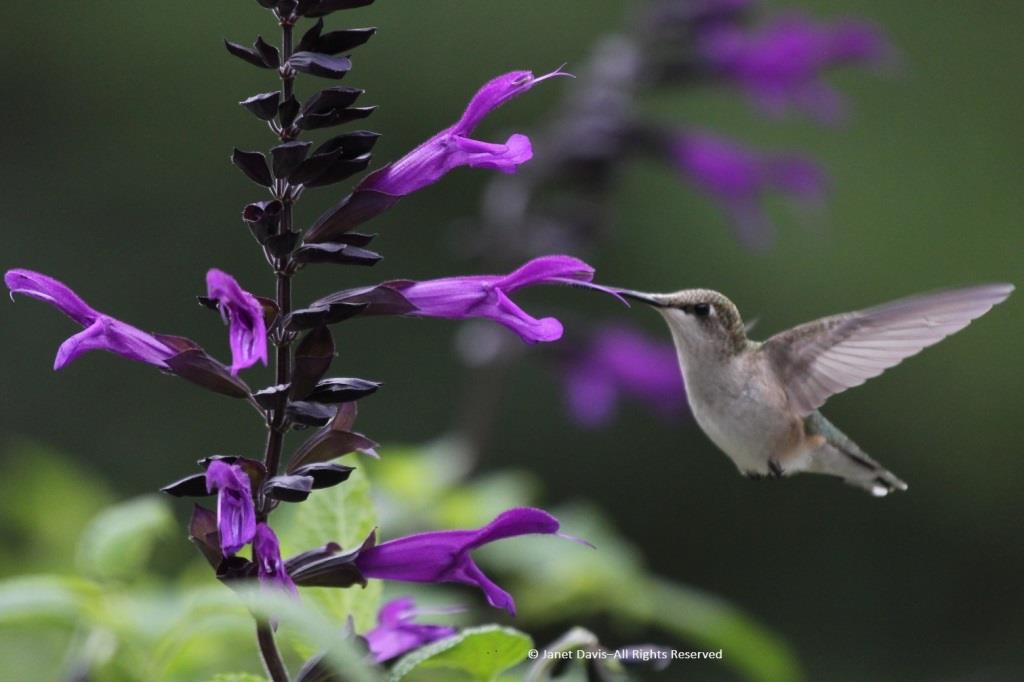
….or Salvia ‘Ember’s Wish’.
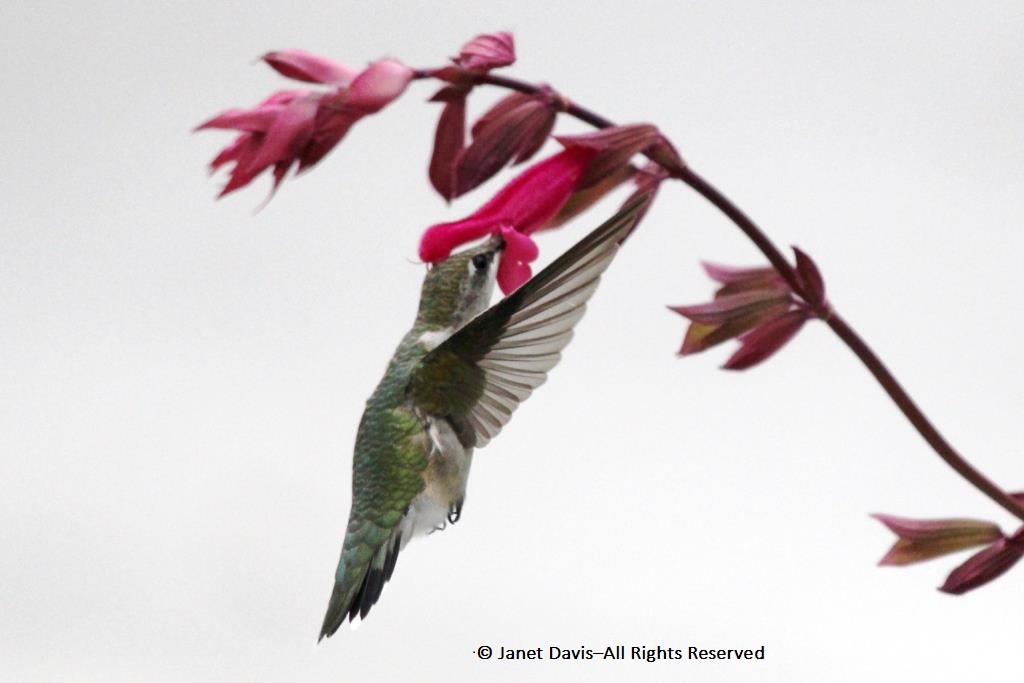
Which brings me to 2020. Actually, let’s go back to November 2019. When I knew my Toronto source for plants of Argentine sage (Salvia guaranitica) was going out of business, I decided to dig up my tender ‘Black and Blooms’ plants and bring them down from Lake Muskoka to the city. I left the pots on the deck in early autumn for my husband to keep watered when I travelled to Greece to take a botanical tour with my pal Liberto Dario. Alas, my husband also travelled to New York on the coldest night of November and my poor sages sat outside in Toronto as the thermometer plunged to -9C. When I came home, they seemed to have died. But I put them in our basement laundry tubs, gave them a watering, and just watched. Sure enough, little leaves emerged eventually and by March they announced themselves ready to greet hummingbirds for another season.
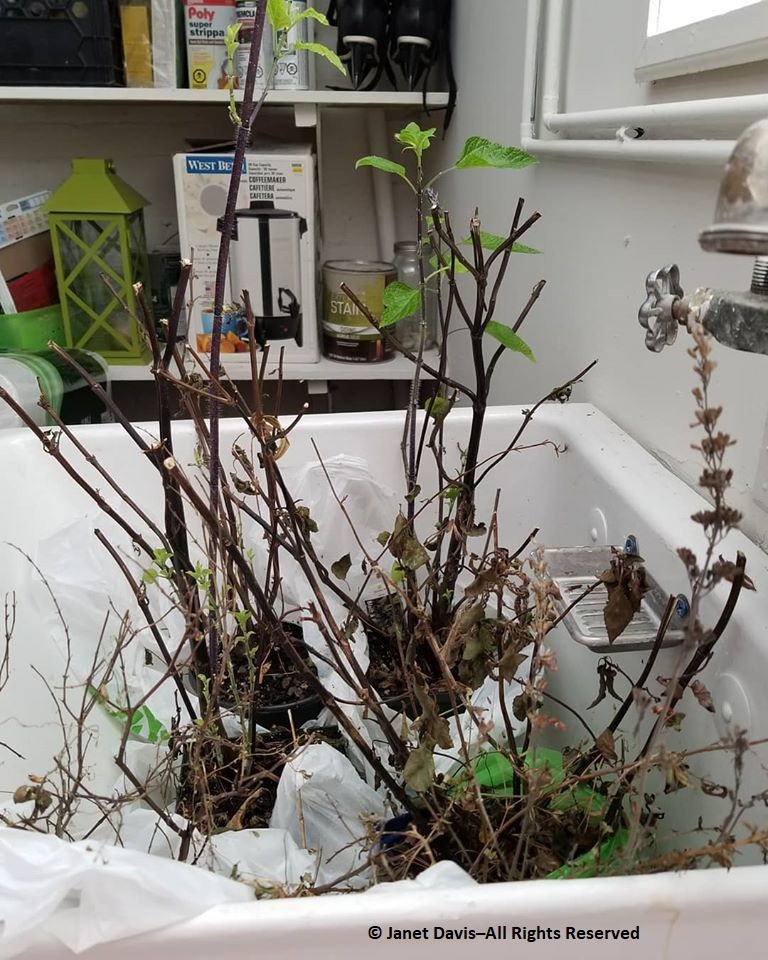
For some reason, perhaps Covid-19!!, I decided that this would be the year I would return to seed-sowing at home. Alas, I had long ago discarded my old basement grow-lights, but I did have a few LED lights for the gooseneck lamps which I sometimes use for small-scale studio photography. And I also had an empty 3rd floor guest bedroom window-seat. Voilà, I had seedlings in April!
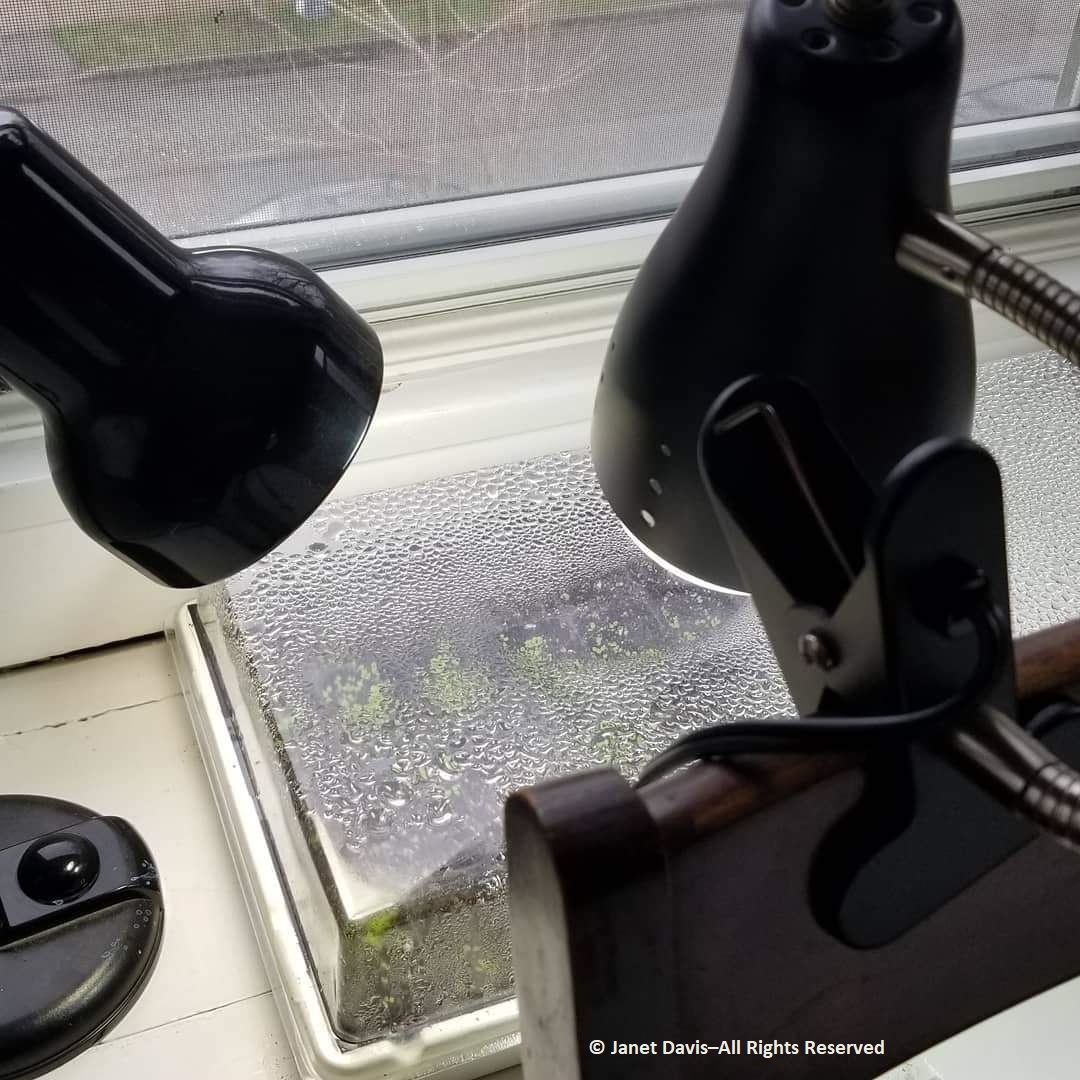
I had long wanted to try sowing Petunia exserta, a rare, threatened endemic from limestone outcrops in the Serras de Sudeste in Brazil. It was first described in 1987; thirty years later, only fourteen plants were found during an expedition. It is reputed to be a good hummingbird plant, so of course I wanted to try it. A friend in Victoria gifted me seeds and it turned out to be amazingly eager to germinate and grow!
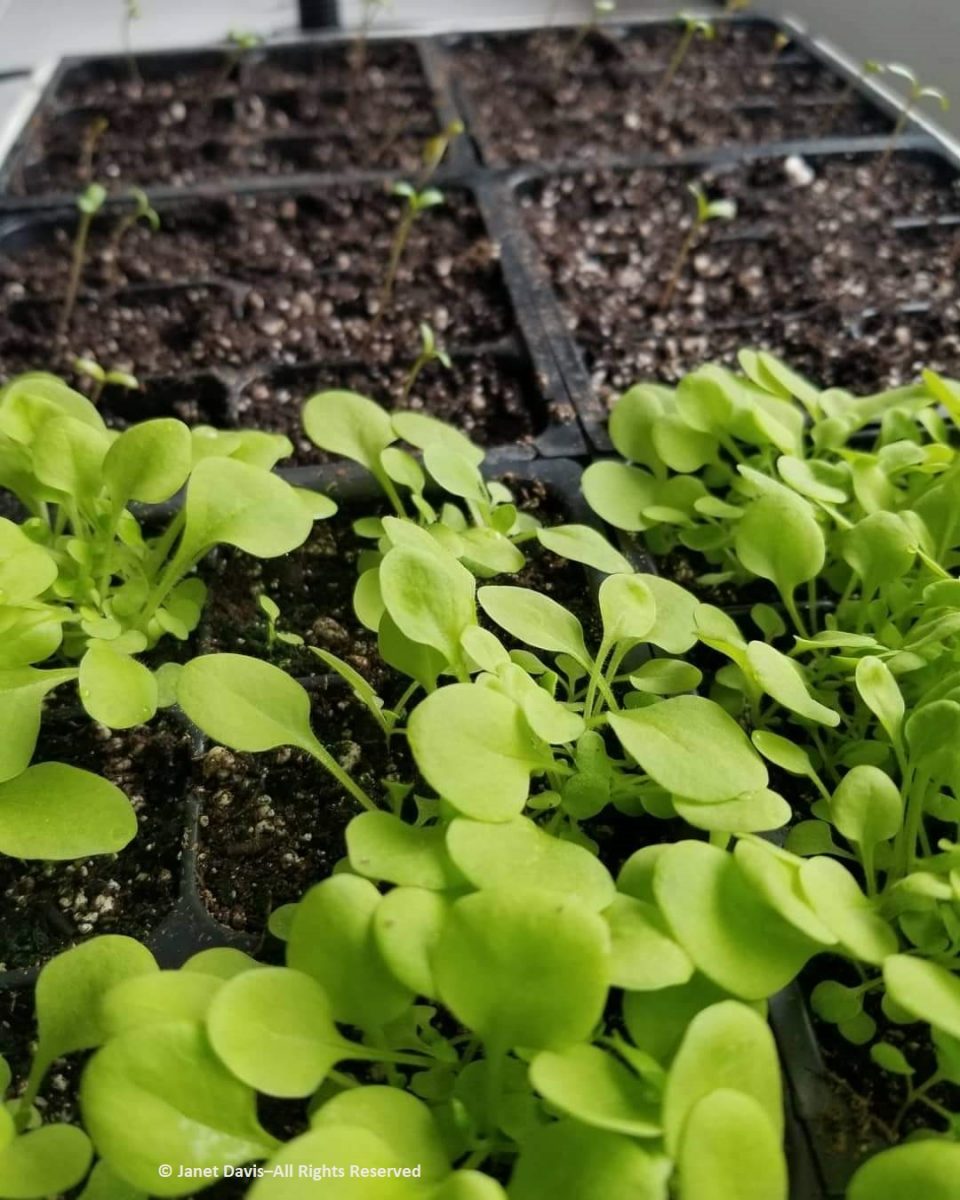
I also thought it would be fun to grow an old French marigold from seed, a tall single form that was supposed to have been grown by Linnaeus himself in his garden in Upssala, Sweden. So I ordered seed for Tagetes patula ‘Burning Embers’. You should know that although this species is called “French” marigold, it’s actually native to Mexico and Guatemala. It got its common name because it was brought back to Europe in the 17th century by Portuguese explorers. The seeds germinated quickly, but they were a little wonky as they twisted vigorously toward the light.
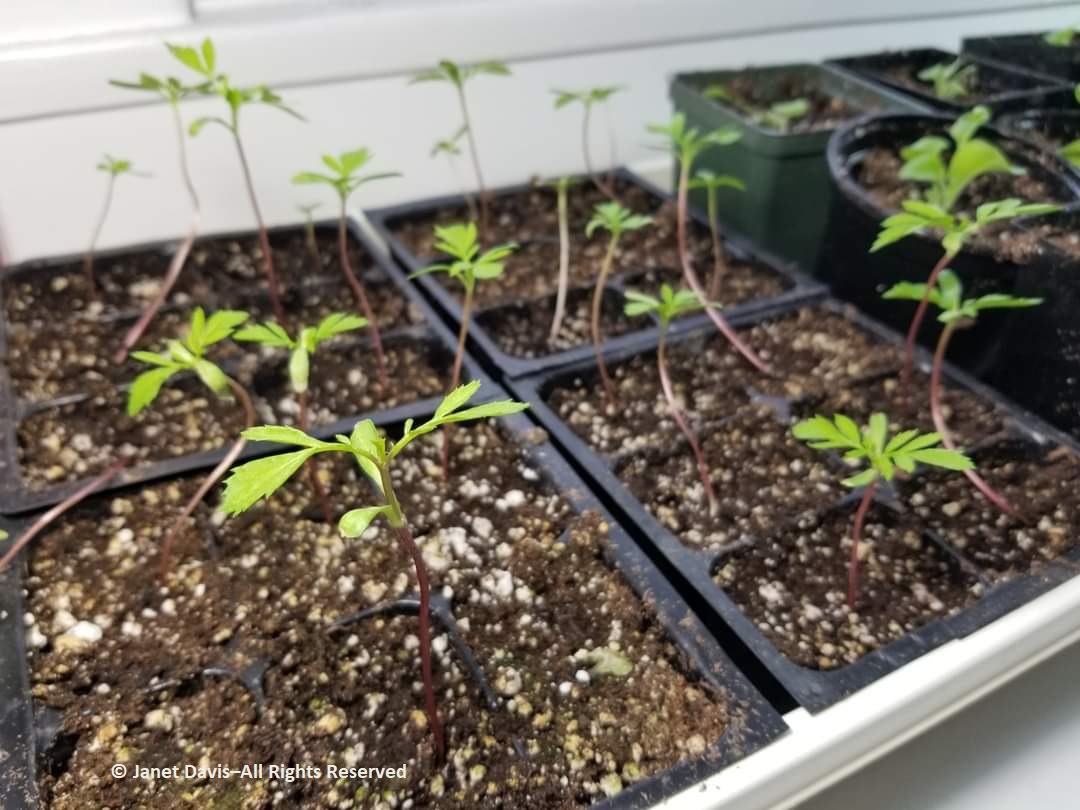
By June, the annuals were planted in Muskoka and the petunias looked stunning.
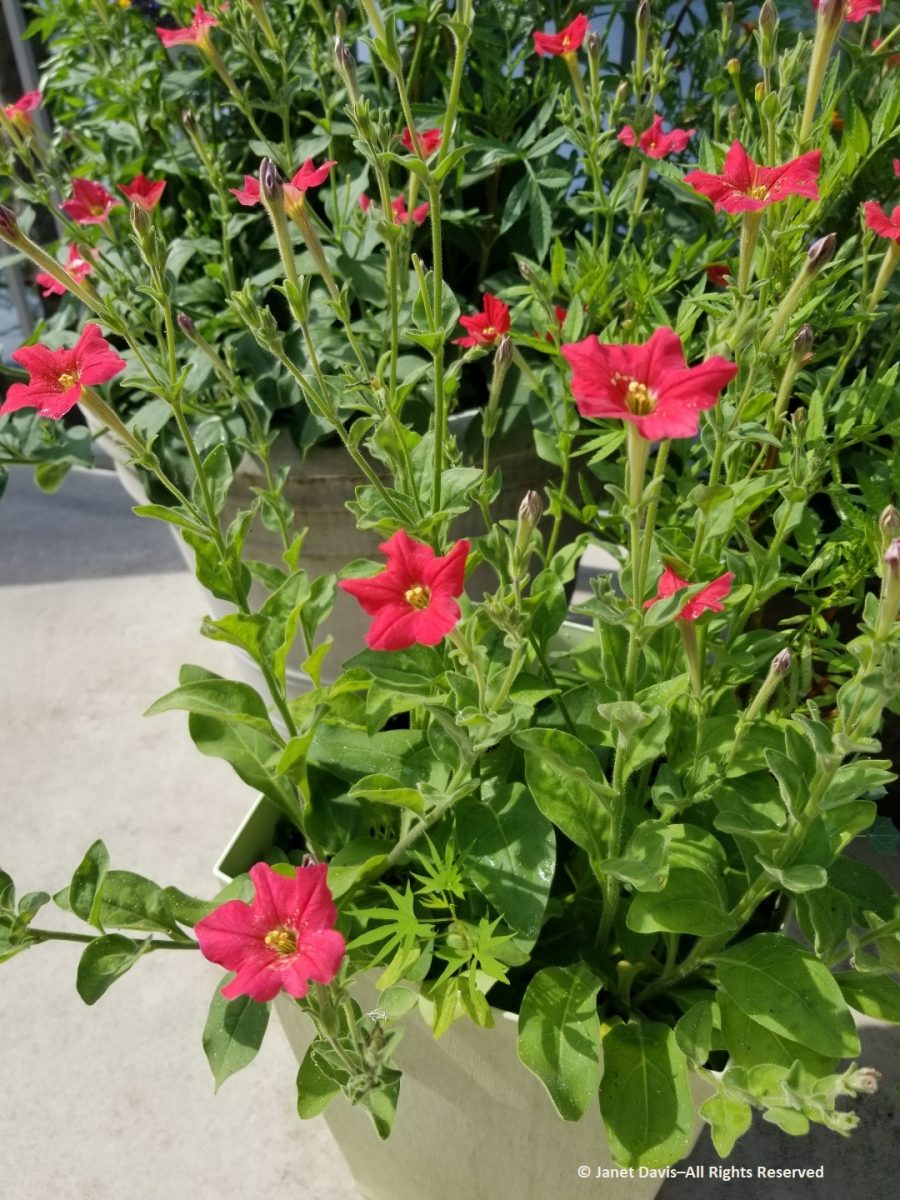
I wasn’t sure if any hummingbirds had found them, but I was convinced later when I saw the watercolour that my son’s girlfriend, Italian artist Marta Motti, made for me as a birthday surprise. That’s the male with his ruby throat, by the way.
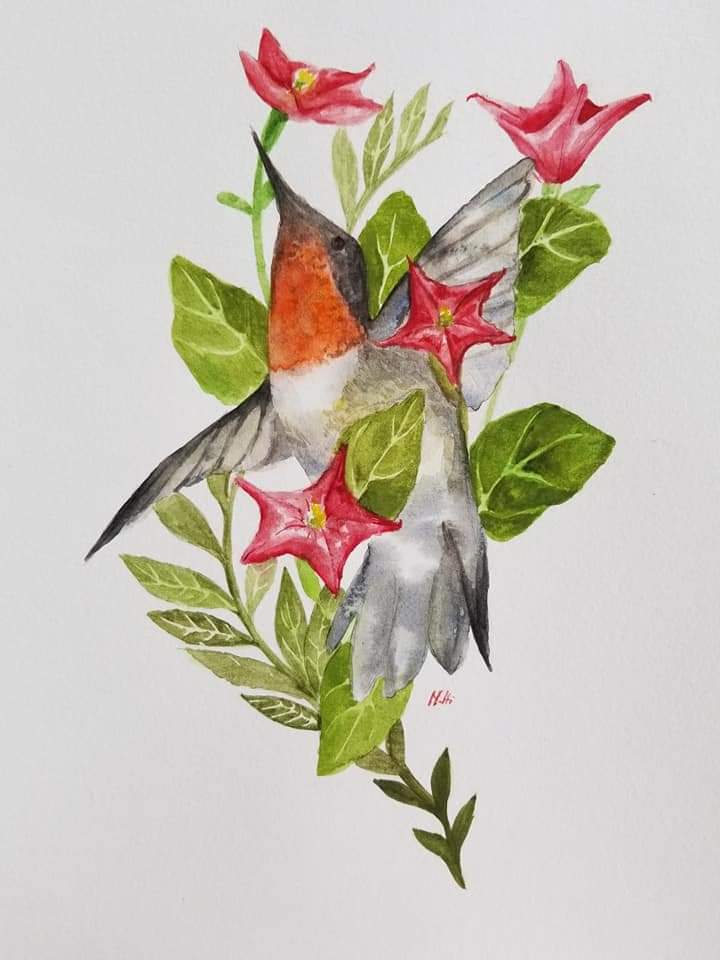
Late June and early July saw an unrelenting heat wave and drought. On July 4th, I put a thermometer on a chair on my sundeck near my pots and it read 104F-40C. It was a huge challenge to keep the pots watered sufficiently, and I realized these two annuals were meant for rich, moisture-retentive meadows, not crowded pots. And the petunias grow upwards in the fashion of indeterminate tomatoes, making flowers only on the end of the shoot and dropping the withered flowers by the dozens. If you want to revive gangly plants, it’s recommended to shear them back in midsummer to the first branching shoots and new growth will form.
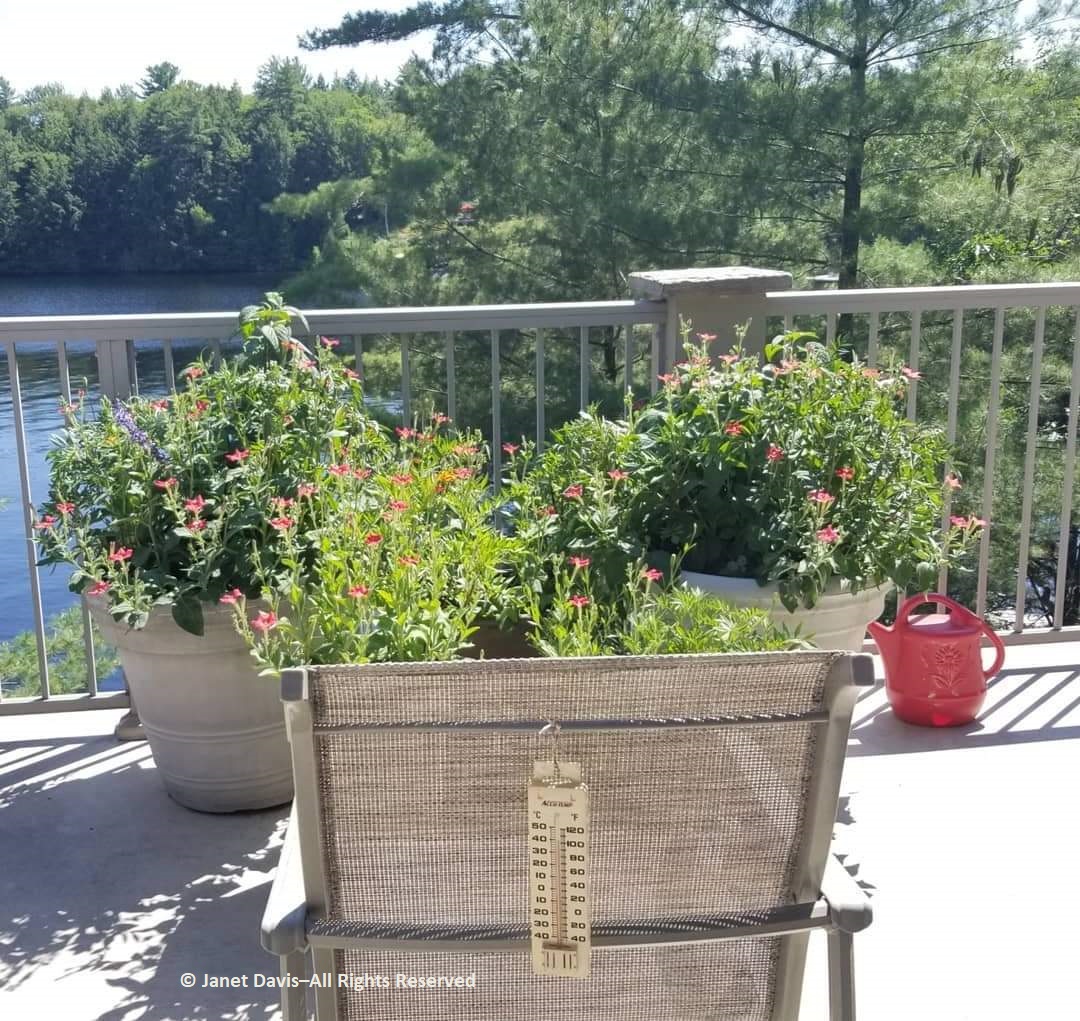
Finally, on July 16th the rains came. It poured. My meadows rejoiced and the motley pots were saturated. I did notice that the bright red of the Petunia exserta faded to a pale rose in the heavy rain, but that seemed to be temporary. Notice that I had added a few rustic willow arbours to host the red morning glory (Ipomoea coccinea) that I seeded in the pots and has yet to flower.
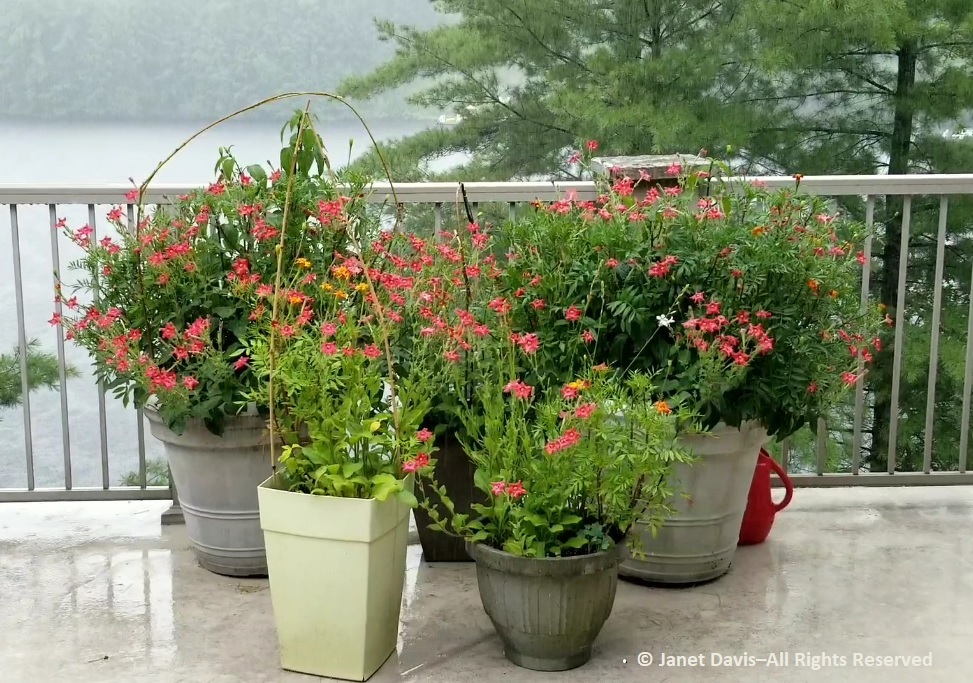
Fast forward a few weeks to mid-August and the pots look wild, overgrown and the most motley they’ve ever been. Fortunately, I’ve never wanted to win a beauty contest with these containers; it’s all about hummingbirds and bees.
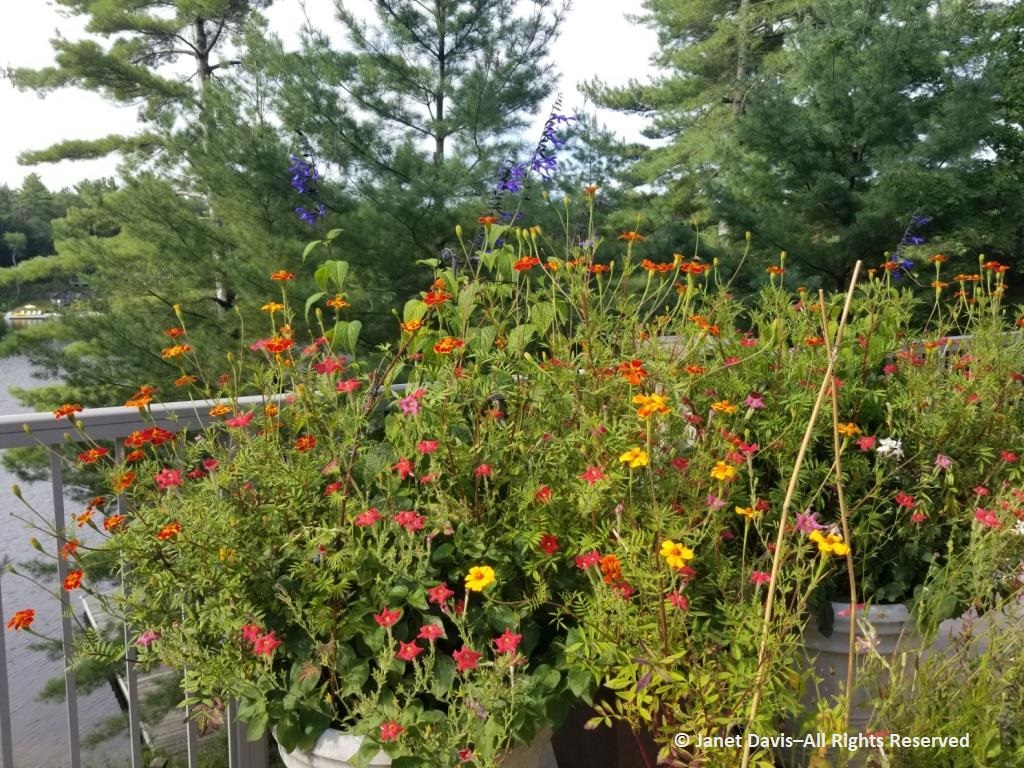
This gold-edged red flower is the classic seed catalogue look of Tagetes patula ‘Burning Embers’,but the seeds I sowed produced a sunset mix of colours, some striped or streaked.
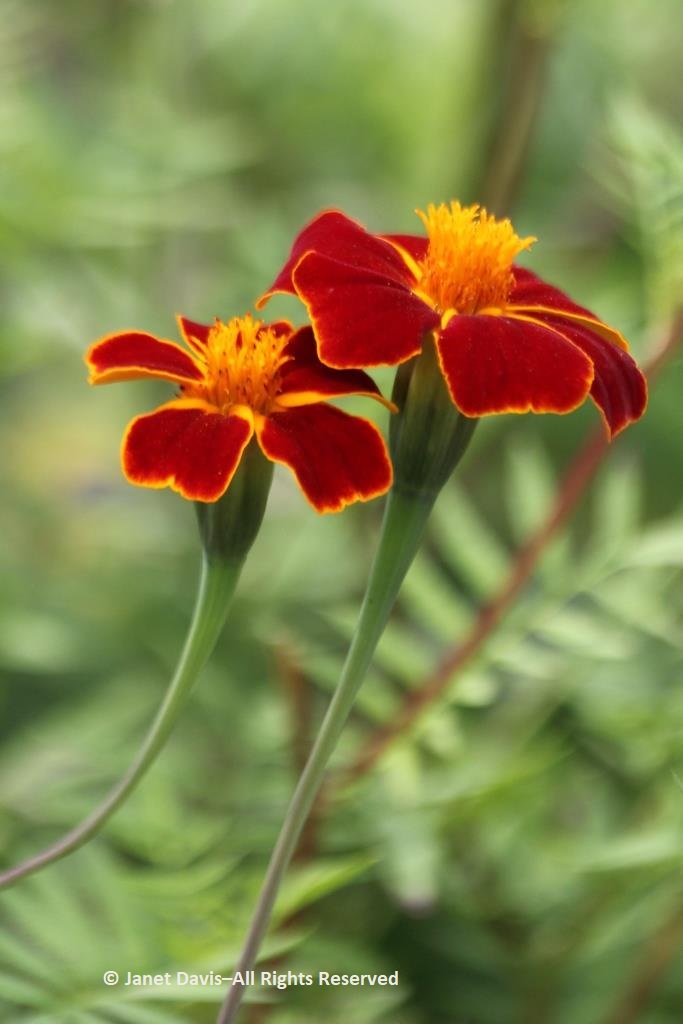
Bumble bees arrived in droves to forage for pollen on them.
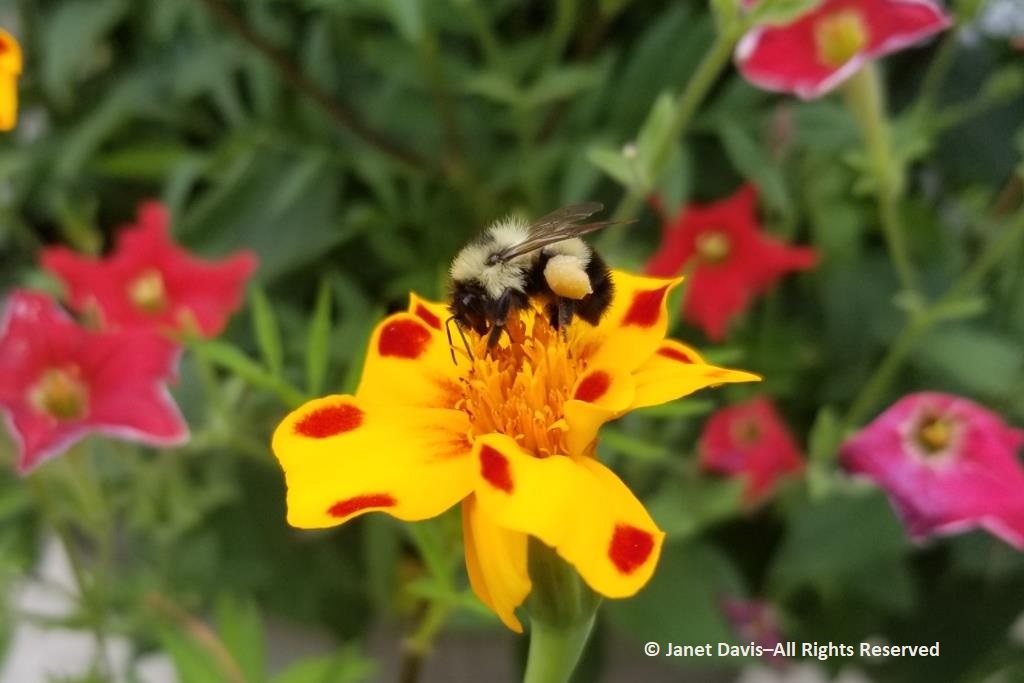
They look very festive with the ‘Black and Blooms’ sage.
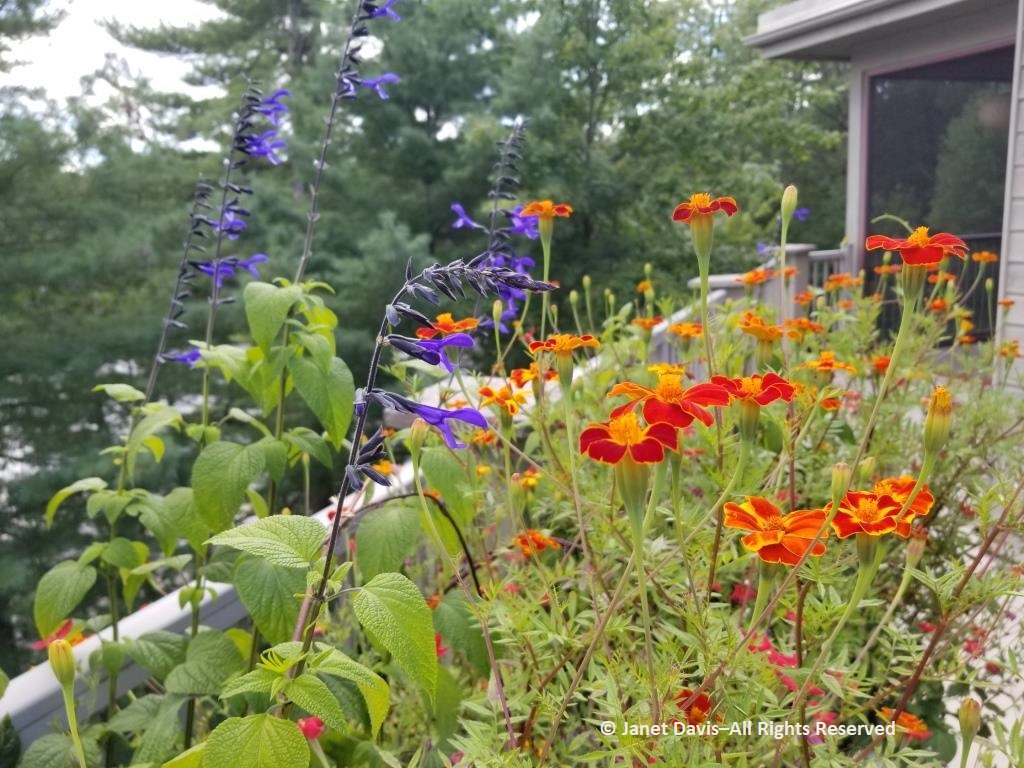
Though they’re usually listed as growing to 18-24 inches (45-60 cm), mine have reached 41 inches (104 cm) and may well grow taller. I was curious about the connection to Linnaeus, and asked my Facebook friend, Swedish ecologist Roger Holt, who was at one time a gardener at the Linnaeus garden. He said: “I asked botanist Jesper Kårehed, responsible for the Linnaeus heritage parts and got the answer that both Linnaeus and his precursor, the universal genius Olof Rudbeck (1630-1702) who built the first Swedish Botanical Garden (that later become the Linnaeus garden), had Tagetes patula (and erecta) and from paintings you can see that Rudbeck had the high elongated forms. In the 1920’s seeds from a form, said to have been picked in the garden of Hammarby, Linnaeus’s private home, started to be around in the trade. The Linnaeus garden was recreated in the 1930’s, and the tagetes have been there all from the start but probably not the same line of seeds.”
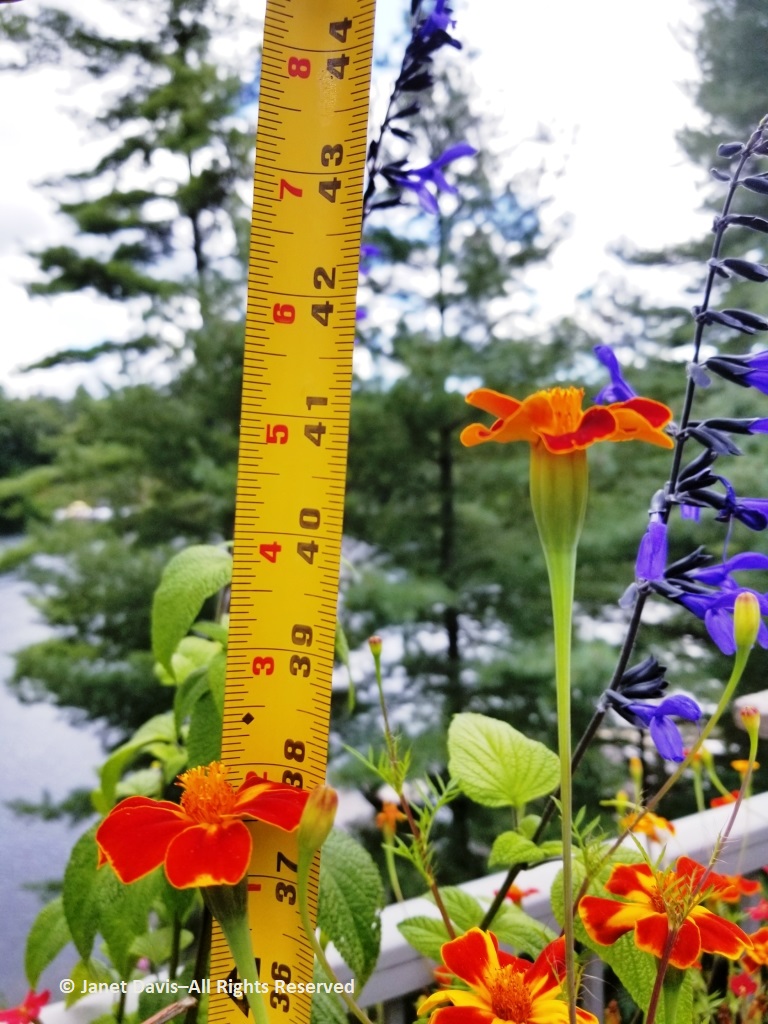
It’s a bit like having Linnaeus’s meadow right outside my window.
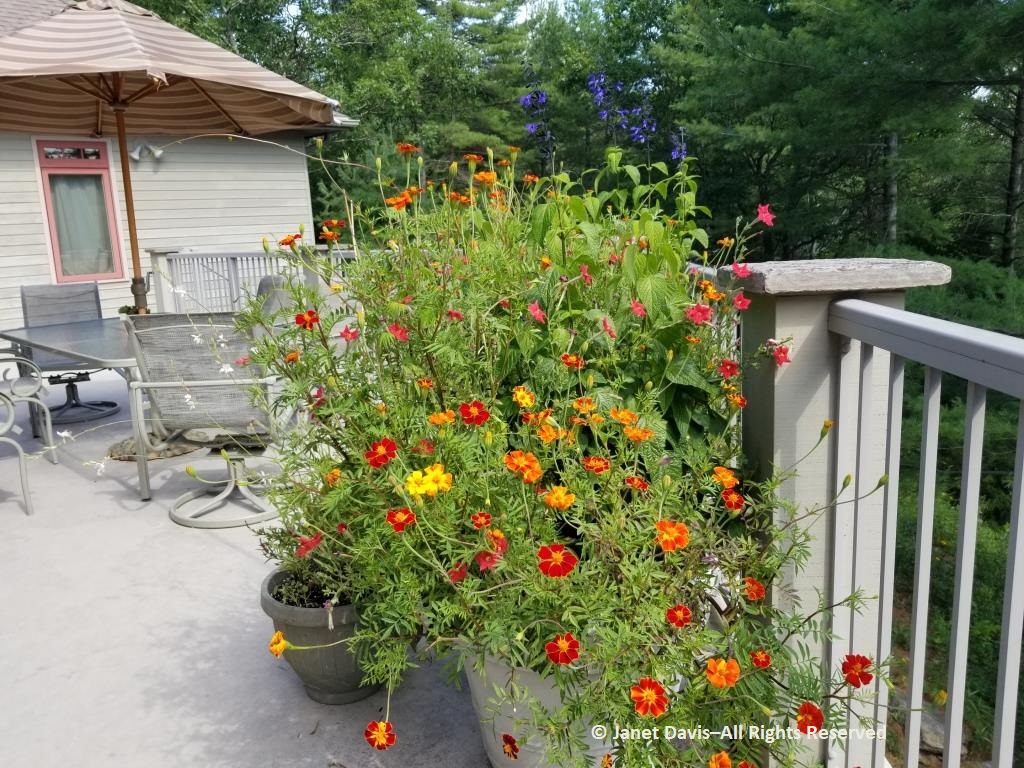
The petunias have hosted the odd wasp, and a handsome slaty skimmer dragonfly made it his sunny hunting perch for a few days.
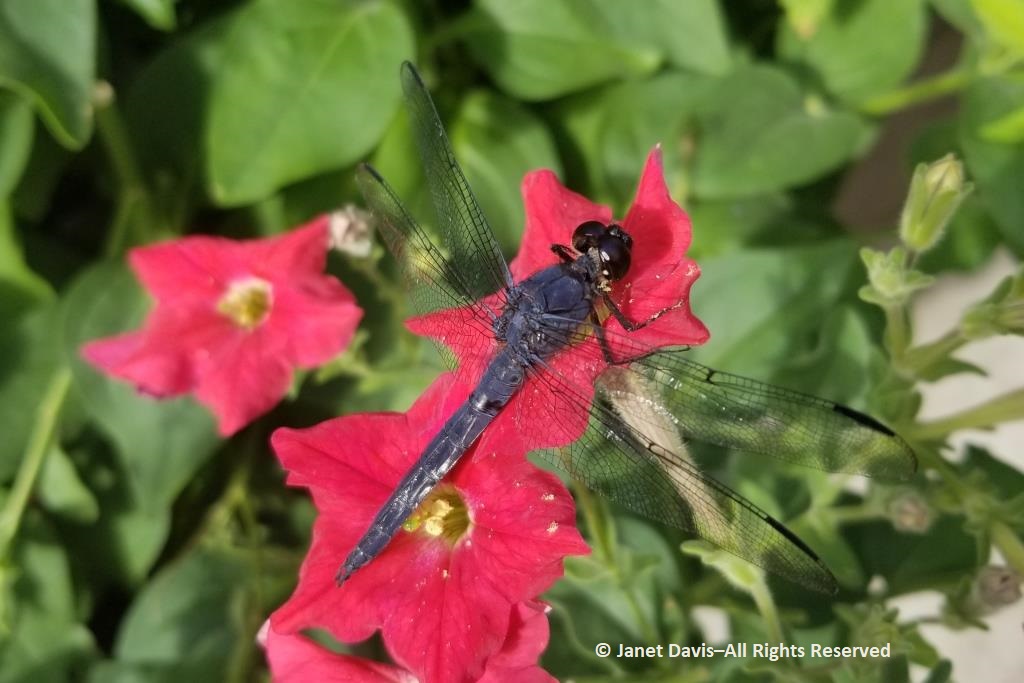
But it has been fun to watch the hummingbird make its way around the flowers, taking a sip out of each.
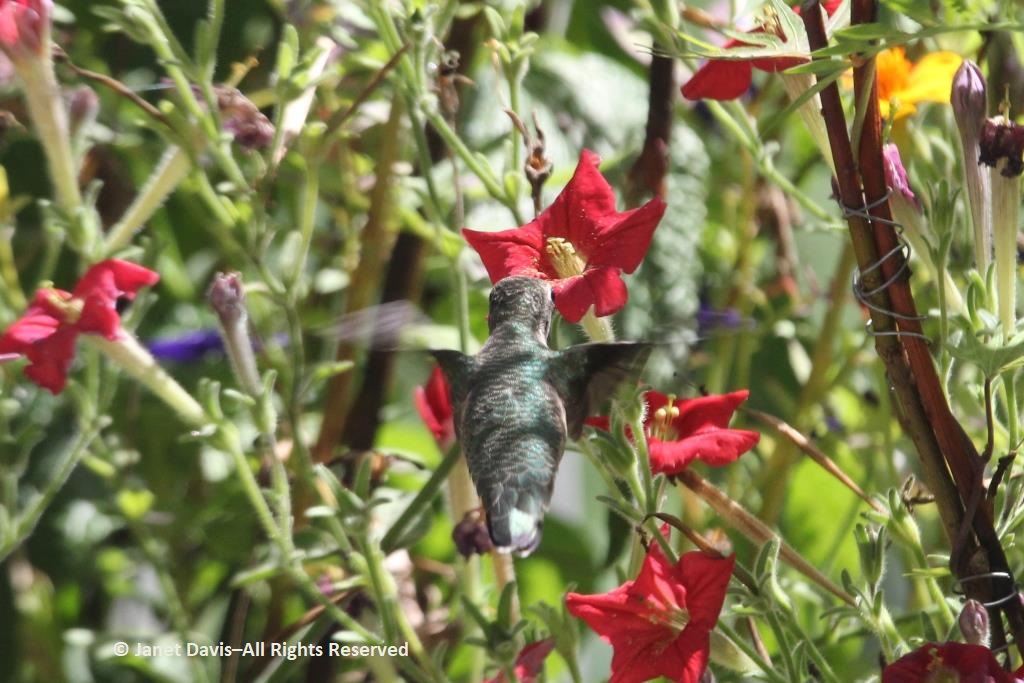
Here’s a little video I made starring Petunia exserta.
However, the champion this summer, as every year, is Salvia guaranitica ‘Black and Blooms’.
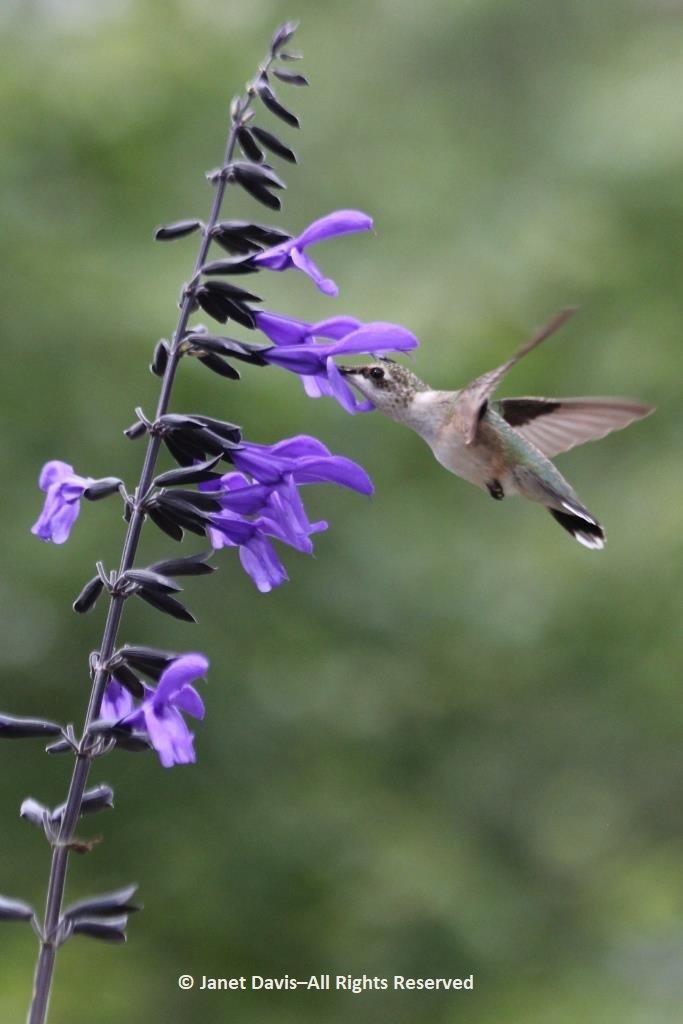
Let me leave you with a musical nod to my motley pots and their faithful feathered visitors.
